KSEEB Class 8 Maths Solutions For Chapter 5 Squares And Square Roots Points To Remember
Square: Number obtained when a number is multiplied by itself. It is the number raised to the power 2, \(2^2=2 \times 2=4\) (square of 2 is 4)
If a natural number m can be expressed as \(\mathrm{n}^2\), where n is also a natural number, then m is a square number.
All square numbers end with 0, 1,4, 5, 6, or 9 at unit’s place.
Square numbers can only have even number of zero’s at the end.
Square root is the inverse operation of square.
There are two integral square roots of a perfect square number.
Positive square root of a number is denoted by the symbol √. For example \(3^2=9\) gives √9=3
Read and Learn More KSEEB Solutions for Class 8 Maths
Perfect square or square number: It is the square of some natural number.If\(\mathrm{m}=\mathrm{n}^2\) , then m is a perfect square number where m and n are natural numbers.
Example: \(1=1 \times 1=1^2\)
\( 4=2 \times 2=2^2\)Properties of square number
| Class 10 Science | Class 11 Chemistry |
| Class 11 Chemistry | Transformation of Sentences |
| Class 8 Maths | Class 8 Science |
(1) A number ending in 2, 3, 7 or 8 is never a perfect square. Ex: 152, 1028 etc.,
(2) A number ending in 0, 1,4, 5, 6 or 9 may not necessarily be a square number Example: 20, 31, 24 etc.,
(3) Square of even numbers are even
Example:\(2^2=4,4^2=16\) etc.
(4) Square of odd numbers are odd
Example: \(5^2 = 25, 9^2 = 81\) etc.,
Kseeb Solutions For Class 8 Maths Chapter 5 Squares And Square Roots
(5) A number ending in an odd number of zeroes cannot be a perfect square
Example: 10,1000, 900000etc.,
(6) The difference of squares of two consecutive natural number is equal to their sum.
\((n +1)^2 — n^2 = n +1 + n\)Example: \(4^2 – 3^2 = 4 + 3 = 7\)
\(12^2 – 11^2 = 12 + 11 =23\) etc.,
(7) A triplet (m, n, p) of three natural numbers m, n and p is called a Pythagorean triplet.
If \( m^2 + n^2 = p^2\)
⇒ \( 3^2 + 4^2 = 25 = 5^2\)
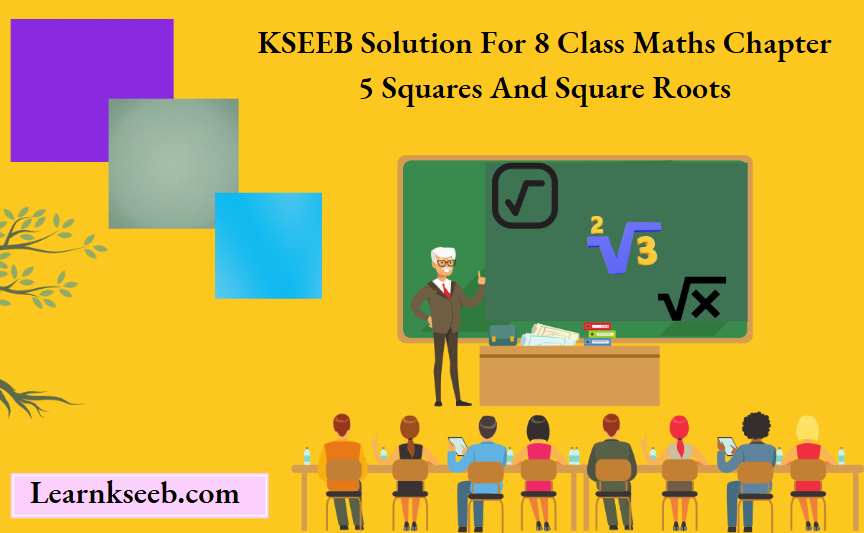
Squares And Square Roots Class 8 Kseeb Solutions Pdf
Squares And Square Roots Solutions KSEEB Class 8 Maths Exercise 5.1
1. What will be the unit digit of the squares of the following numbers?
1)81
2)272
3)799
4)3853
5)1234
6)26387
7)52698
8)99880
9)12796
10)55555
Solution: wkt, if a number has its unit’s place digit as a then its square, will end with the unit digit of the multiplication a x a.
1) 81 since the given number has its unit’s pace digit as 1, its square will end with the unit digit of the multiplication (1 x 1 = 1) i.e., 1
2) 272 Since the given number has its unit’s place digit as 2 its square will end with the unit digit of the multiplication (2×2 = 4) i.e., 4.
3) 799 Since the given number has its unit’s place digit as 9 its square will end with the unit digit of the multiplication (9 x 9 = 81) i.e., 1
4)3853 Since the given number has its unit’s place digit as 3 its square will end with the unit digit of the mul¬tiplication (3 x 3 = 9) i.e., 9
5)1234 Since the given number has its unit’s place digit as 4 its square will end with the unit digit of the multiplication (4 x 4 = 16) i.e., 16
6)26387 Since the given number has its unit’s place digit as 7 its square will end with the unit digit of the multiplication (7 x 7 = 49) i.e., 9
7)52698 Since the given number has its unit’s place digit as 8 its square will end with the unit digit of the multiplication (8 x 8 = 64) i.e., 4
8)99880 Since the given number has its unit’s place digit as 0 its square will have two zeroes at the end
∴ The unit digit of the square of the given number is 0.
9)12796 Since the given number has its unit’s place digit as 8, its square will end with the unit digit of the multiplication (6 x 6 = 36) i.e., 6
10)55555 Since the given number has its unit’s place digit as 5 its square will end with the unit digit of the multiplication (5×5= 25) i.e., 5
Class 8 Maths Chapter 5 Kseeb Solutions Karnataka Board
2. The following numbers are obviously not perfect squares. Give reason.
1)1057
2)23453
3)7928
4)222222
5)64000
6)89722
7)222000
8)505050
Solution: The square of numbers may end with any one of the digits 0, 1,5, 6 or 9. Also, a perfect square has even number of zeroes at the end of it.
1) 1057 has its unit place digit as 7
∴ it cannot be a perfect square.
2) 23453 has its unit place digit as 3
∴ it cannot be a perfect square.
3) 7928 has its unit place digit as 8
∴ it cannot be a perfect square.
4) 222222 has its unit place digit as 2
∴ it cannot be a perfect square.
5) 64000 has three zeros at the end ofit. However, since a perfect square cannot end with odd number of zeroes, it is not a perfect square.
6) 89722 has its unit place digit as 2
∴ it cannot be a perfect square.
7) 222000 has three zeros at the end ofit. However, since a perfect square cannot end with odd number of zeroes, it is not a perfect square.
8) 505050 has one zero at the end of it, However since a perfect square cannot end with odd number of zeroes, it is not a perfect square.
Kseeb Class 8 Maths Chapter 5 Important Questions And Answers
3. The squares of which of the following would be odd numbers?
1)431
2)2826
3)7779
4)82004
Solution: The square of an odd number is odd and the square of an even number is even. Here 431 and 7779 are odd numbers.
Thus, the square of 431 and 7779 will be an odd number.
4. Observe the following pattern and find the missing digits. \( 11^2 = 121\)
\( 101^2 = 10201\)
\( 1001^2 = 1002001\)
\( 100001^2 = 1—-2—–1\)
\( 10000001^2= —–\)
Solution: In the given pattern, it can be observed that the squares of the given numbers have the same number of zeroes before and after the digit 2 as it was in the original number.
∴ \( 100001^2 = 10000200001\)
\( 10000001^2= 100000020000001\)5. Observe the following pattern and supply the
missing number.
\( 11^2 = 121\)
\( 101^2 = 10201\)
\( 10101^2 = 102030201\)
\( 1010101^2 = \)
\( ^2 = 10203040504030201\)
Solution: By following the given pattern, we obtain
\( 1010101^2= 1020304030201\) \( 101010101^2 =10203040504030201\)6. Using the given pattern, find the missing numbers
\(l^2 + 2^2 + 2^2 = 3^2\)
\(2^2 + 3^2 + 6^2 = 7^2\)
\( 3^2 + 4^2 + 12^2 = 13^2\)
\( 4^2 + 5^2 + ^2 = 21^2\)
\( 5^2 + ^2 + 30^2 = 31^2\)
\( 6^2 + 7^2 + ^2 = ^2\)
Solution: From the given pattern, it can be observed that
1) The third number is the product of the first two numbers.
2) The fourth number can be obtained by adding
1 to the third number. Thus, the missing numbers in the pattern will be as follows.
\( 4^2+ 5^2+ 20^2 = 21^2\) \( 5^2+_6^2 + 30^2 = 31^2\) \( 6^2+ 7^2+ 42^2 = 43^2\)Karnataka Board Class 8 Maths Chapter 5 Textbook Solutions
7. Without adding find the sum.
1)1+ 3 + 5 + 7 + 9
2) 1 + 3 + 5 + 7 + 9 + 11 + 13 + 15 + 17 + 19
3) 1+3 + 5 + 7 + 9 + 11 + 13 + 15 + 17 + 19+ 21+ 23
Solution: wkt The sum of first ‘n’ odd natural number is n^2.
1) Here, we have to find the sum of first five odd natural numbers.
∴ \(1 + 3 + 5 + 7 + 9 = 5^2 = 25\)
ii) Here, we have to find the sum of first ten odd natural numbers.
∴\(1+3 + 5 + 7 + 9+11 + 13 + 15+17+19 = 10^2 = 100\)
iii) Here, we have to find the sum of first twelve odd natural numbers.
∴ \(1+3 + 5 + 7 + 9+11 + 13 + 15+17+19+21+23 = 12^2=144\)
8. 1) Express 49 as the sum of 7 odd numbers.
Solution: wkt The sum of first ‘n’ odd natural numbers is \(n^2\).
\(49 = 7^2\)∴ 49 is the sum of first 7 odd natural numbers
49=1+3 + 5 + 7 + 9+11 + 13
2) Express 121 as the sum of 11 odd numbers.
Solution: \(121 = ll^2\)
∴ 121 is the sum of first 11 odd natural numbers.
121 = 1+ 3 + 5 + 7 + 9+11 + 13 + 15+17 + 19 + 21
KSEEB Maths Class 8 Squares and Square Roots Notes
9. How many numbers lie between squares of the following numbers?
1) 12 & 13
2) 25 & 26
3) 99 and 100.
Solution: wkt There will be 2n numbers in between the squares of the numbers n and (n + 1)
1) \(12^2 13^2\), there will be 2 x 12 = 24 numbers.
2) \(25^2 26^2\), there will be 2 x 25 = 50 numbers.
3) \(99^2 100^2\), there will be 2 x 99 =198 numbers.
KSEEB Class 8 Maths Chapter 5 Square And Square Roots Exercise 5.2
1. Find the square of the following numbers.
1) 32
Solution: \(32 = (30 + 2)^2 = 30(30 + 2) + 2 (30+2)\)
= \(30^2 + 30 x 2 + 2 x 30 + 2^2\)
= 900 + 60 + 60 + 4
= 1024
2)35
Solution: 35 = 3 (3 + 1) hundreds + 25
= (3×4) hundreds + 25
= 1200 + 25
= 1225
3) 86
Solution: \(86^2 = (80 + 6)^2\)
= 80 (80 + 6) + 6 (80 + 6)
= \(80^2 + 80 x 6 + 6 x 80 + 6^2\)
= 6400 + 480 + 480 + 36
= 7396
4) 93
Solution: \( (93)^2 = (90 + 3)^2\)
= 90 (90 + 3) + 3 (90 + 3)
= \( 90^2 + 90 x 3 + 3 x 90 + 3^2 \)
= 8100 + 270 + 270 + 9
= 8649
5) 71
Solution: \( (71)^2 = (70 + l)^2\)
= 70(70+ 1)+ 1 (70+ 1)
= \( 70^2 + 70 x 1 + 1 x 70 + 1\)
= 4900 + 70 + 70+1
= 5041
6)46
Solution: \( 46^2 = (40 + 6)^2\)
= 40 (40 + 6) + 6 (40 + 6)
= \( 40^2 + 40 x 6 + 6 x 40 + 6^2\)
= 1600 + 240 + 240 + 36
= 2116
2. Write a Pythagorean triplet whose one member is
1) 6
2) 14
3) 16
4) 18
Solution: For any natural number m > 1, 2m,\( m^2 – 1, m^2 + 1\) forms a pythagorean triplet.
1) if we take \( m^2 + 1 = 6\) , then \( m^2 = 5\) The value of m will not be an integer.
If we take m2 – 1 = 6, then m2 = 7 Again the value of m is not an integer.
Let 2m = 6
m = 3
∴ The pythagorean triplets are \(2 x 3, 3^2 – 1, 3^2 + 1 or 6, 8 and 10\)
2) 14
If we take \(m^2 + 1 = 14, then m^2 = 13\) The value of m will not be an integer.
If we take \(m^2 – 1 = 14, then m^2 = 15\)
Again the value of m is not an integer.
Let 2m =14⇒ m = 7
Thus, \(m^2 – 1 = 49 – 1 = 48\) and
\(m^2 + 1 = 49 + 1 = 50\)3) 16
If we take \(m^2 + 1 = 16, then m^2 = 15\) The value of m will not be an integer.
If we take \(m^2 – 1 = 16, then m^2 = 17\)
Again the value of m is not an integer.
Let 2m =16⇒ m = 8
Thus, \(m^2 – 1 = 64 – 1 = 63\) and
\(m^2 + 1 = 64 + 1 = 65\)∴ The Pythagorean triplet is 16,63 and 65
4) 18
If we take \( m^2 + 1 = 18, then m^2 = 17\)
The value of m will not be an integer.
If we take \( m^2 – 1 = 18, then m^2 = 19\)
Again the value of m is not an integer.
Let 2m =18 ⇒ m = 9
Thus, \( m^2-1=81-1=80\) and
\( m^2+1=81+1=82\)∴ The Pythagorean triplet is 18, 80 and 82
Solutions For Squares And Square Roots KSEEB Maths Exercise 5.3
1. What could be the possible one’s digits of the square root of each of the following numbers?
1) 9801
Solution: If the number ends with 1, then the one’s digit of the square root of that number may be 1 or 9.
∴ one’s digit of the square root of 9801 is either 1 or 9.
2) 99856
If the number ends with 6, then the one’s digit of the square root of th at number may be 4 or 6.
∴ one’s digit of that square root of 99856 is either 4 or 6.
3) 998001
If the number ends with 6, then the one’s digit of the square root of that number may be 1 or 9.
∴ one’s digit of the square root of 998001 is either 1 or 9
4) 657666025
If the number ends with 5, then the one’s digit of the square root of that number will be 5.
∴ The one’s digit of the square root of 657666025 is 5.
Kseeb Solutions For Class 8 Maths Squares And Square Roots Formulas
2. Without doing any calculation, find the numbers which are surely not perfect squares
1) 153
2)257
3) 408
4) 441
Solution: The perfect squares of a number can end with any of the digits 0, 1,4, 5, 6 or 9 at units place. Also, a perfect square will end with even number of zeroes, if any.
i) since the number 153 has its unit’s place digit as 3 it is not a perfect square
ii) since the number 257 has its unit’s place digit as 7 it is not a perfect square.
iii) since the number 408 has its unit’s place digit as 8. it is not a perfect square.
iv) since the number 441 has its unit’s place digit as 1. It is a perfect square.
Squares And Square Roots Problems In KSEEB Maths
3. Find the square roots of 100 and 169 by the method of repeated subtraction.
Solution: w.k.t. the sum of the first n odd natural numbers is \( n^2\) .
consider √100
1)100 – 1 = 99
2)99 – 3 = 96
3)96-5 = 91
4)91 -7 = 84
5)84- 9 = 75
6)75 – 11 = 64
7)64-13 = 51
8)51 – 15 = 36
9)36- 17= 19
10)19- 19 = 0
We have subtracted successive odd numbers starting from 1 to 100 and obtained 0 at 10th step.
∴ √100=10
The square root of 169 can be obtained by the method of repeated subtractions as follows.
1) 169- 1 = 168
2) 168-3 = 165
3) 165 -5 = 160
4) 160-7 = 153
5) 153-9 = 144
6) 144-11 = 133
7) 133 – 13 = 120
8) 120 – 15 = 105
9) 105 – 17 = 88
10) 88 – 19 = 69
11) 69-21 =48
12) 48 – 23 = 25
13) 25 – 25 = 0
We have subtracted successive odd numbers starting from 1 to 169 and obtained 0 at 13th step.
∴ √169=13
4. Find the square roots of the following numbers by the prime Factorisation method.
1) 729
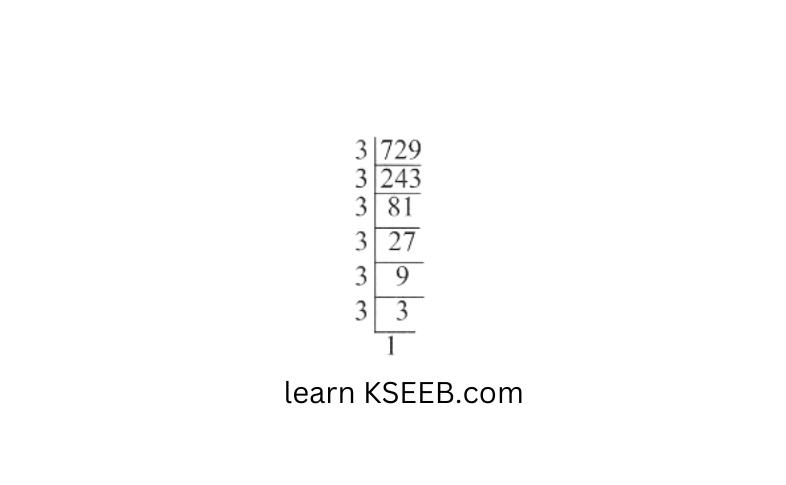
Solution: 729= 3x3x3x3x3x3
√729= 3x3x3
=27
2)400

Solution: 400= 2x2x2x2x5x5
√400= 2x2x5
=20
3)1764
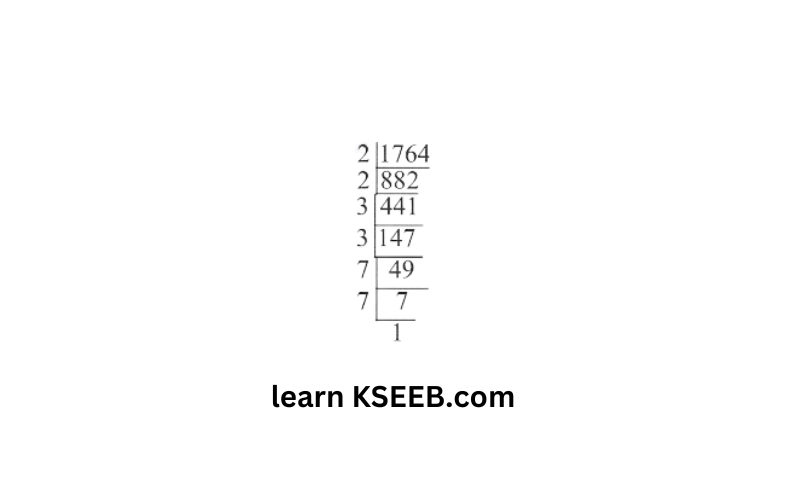
Solution: 1764= 2x2x3x3x7x7
√1764= 2x3x7
∴√1764= 42
4)4096
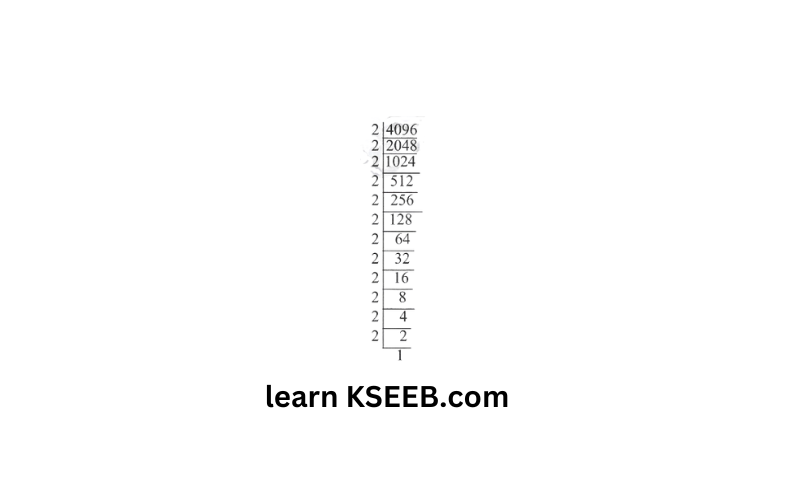
Solution: 4096= 2x2x2x2x2x2x2x2x2x2x2x2
∴√4096= 2x2x2x2x2x2
= 64
5)7744
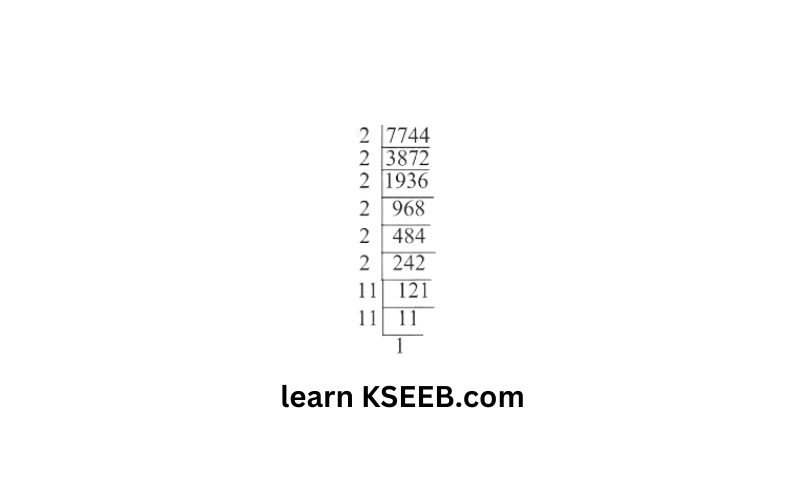
Class 8 Maths Squares And Square Roots Kseeb Solved Examples
Solution: 7744= 2x2x2x2x2x2x11x11
∴√7744= 2x2x2x11
= 88
6) 9064
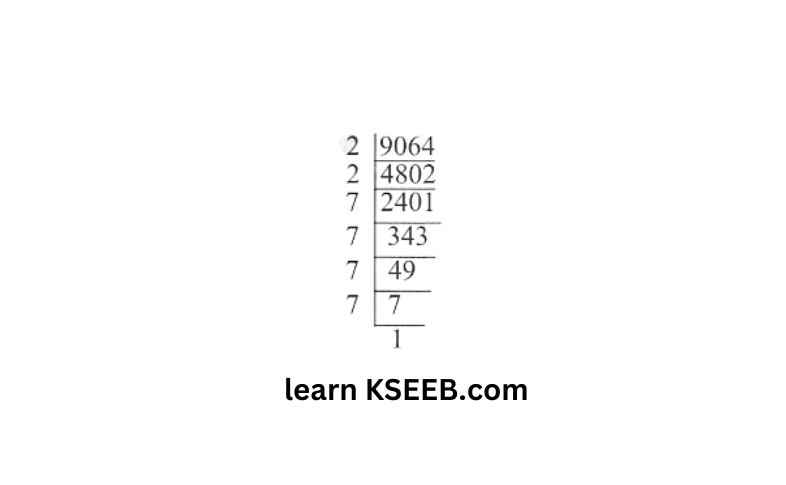
Solution: 9064= 2x2x7x7x7x7
∴√9064= 2x7x7
= 98
7) 5929
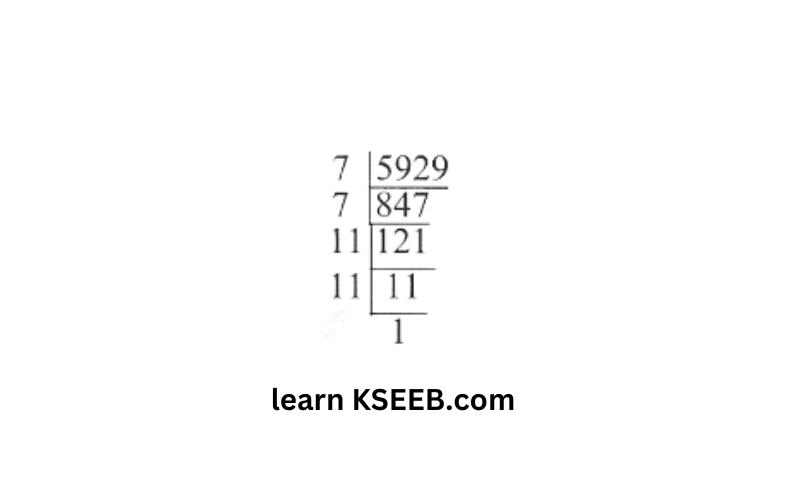
Solution: 5929= 7x7x11x11
∴√5929= 7×11
= 77
8) 9216
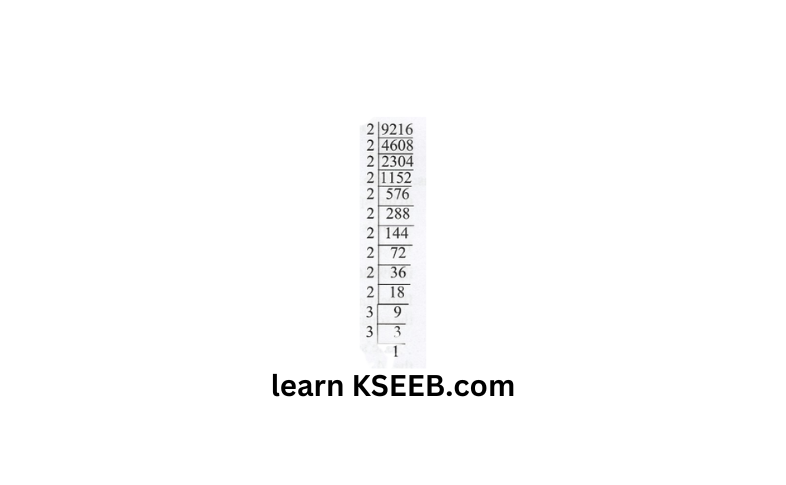
Solution: 9216=2x2x2x2x2x2x2x2x2x2x3x3
=2x2x2x2x2x3
√9216=96
9) 529

Solution: √529=23
10) 8100
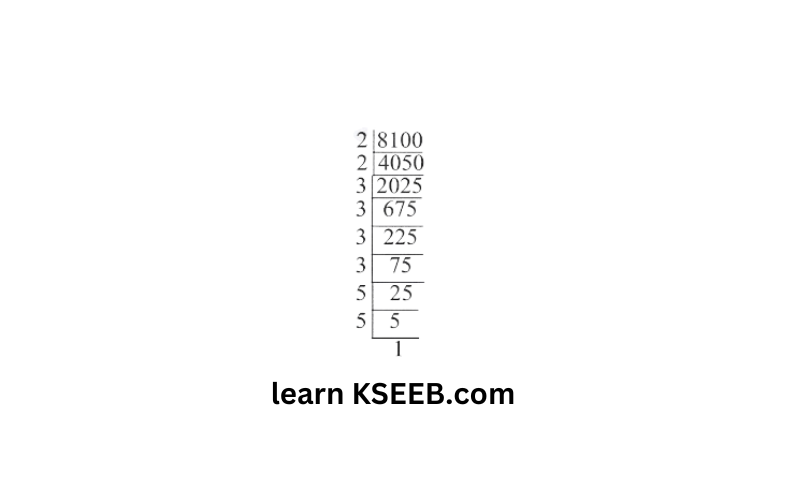
Solution: 8100= 2x2x3x3x3x3x5x5
√8100= 2x3x3x5
=90
KSEEB Class 8 Maths Key Concepts Of Squares And Square Roots
5. For each of the following numbers, find the smallest whole number by which it should be multiplied so as to get a perfect square number. Also, find the square root of the square number so obtained.
1)252
2)180
3)1008
4)2028
5)1458
6)768
Solution:
1)252
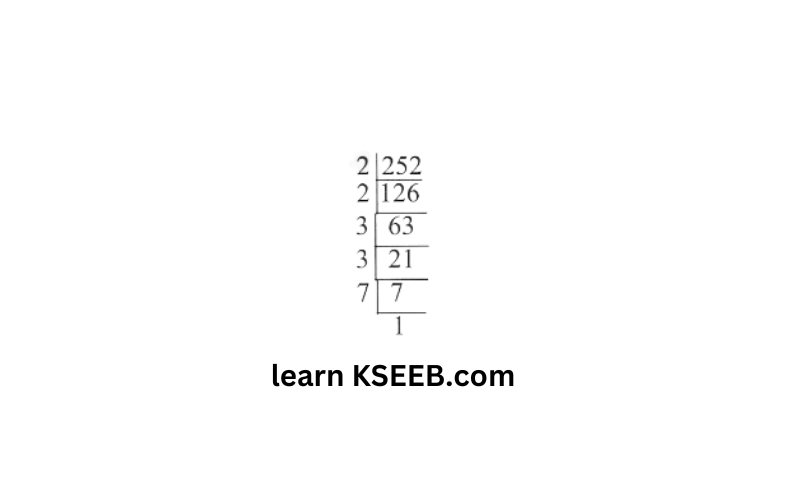
252 = 2 x 2 x 3 x 3 x7
Here, prime factor 7 does not have its pair.
If 7 gets a pair, then the number will become a perfect square.
∴ 252 has to be multiplied with 7 to obtained a perfect square
252 x7 = 2x2x3x3 x7 x7
∴252 x 7 = 1764 is a perfect square
∴ √1764 =2x3x7
= 42
2) 180
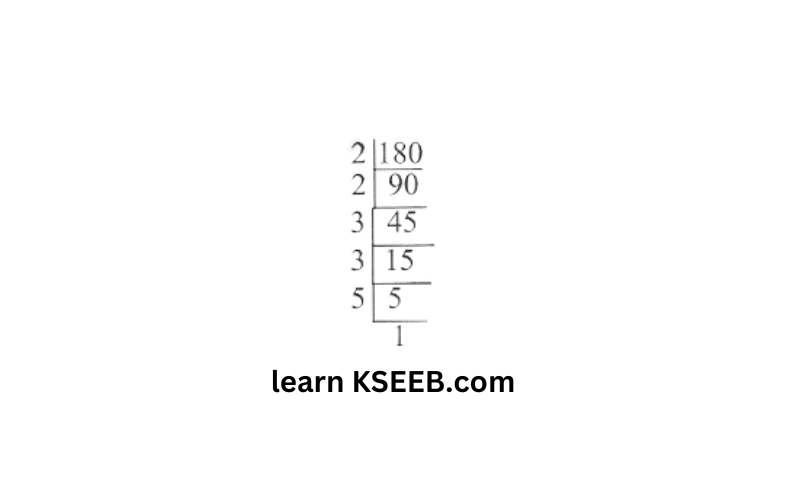
180= 2x2x3x3x5
Here, prime factor 5 does not have its pair, if 5 gets a pair, then the number will become a perfect square.
∴ 180 has to be multiplied with 5 to obtain a perfect square.
180 x 5 = 900 = 2 x 2 x 3 x 3 x 5×5
∴ 180 x 5 = 900 is a perfect square.
∴ √900 = 2X3X5 = 30
3) 1008
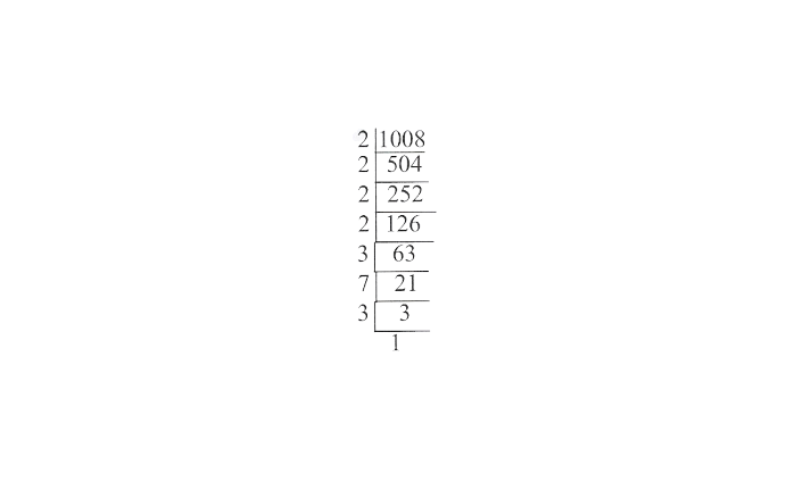
1008= 2x2x2x2x3x3x7
Here, prime factor 7 does not have its pair, If 7 gets a pair, then the number will become a perfect square.
∴ 1008 can be multiplied with 7 to obtained a perfect square.
1008×7 = 7056 = 2x2x2x2x3x3x7x7
∴ 1008×7 = 7056 is a perfect square.
∴ √7056 = 2x2x3x7 =84
4) 2028
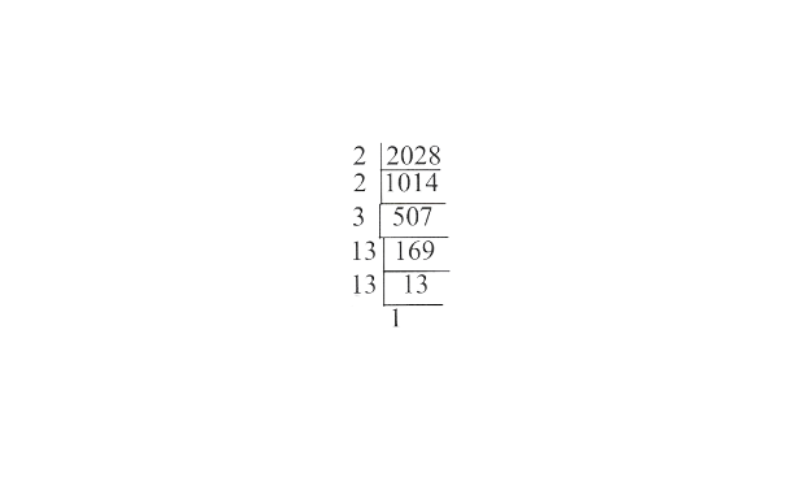
2028= 2x2x3x13x13
Here prime factor 3 does not have its pair, If 3 gets a pair, then the number will become a perfect square. 1
∴ 2028 has to be multiplied with 3 to obtain a perfect square.
∴ 2028 x 3 = 6084 is a perfect square
2028 x 3 = 6084= 2x2x3x3x13x13
∴ √6084 = 2x3x13 = 78
5) 1458
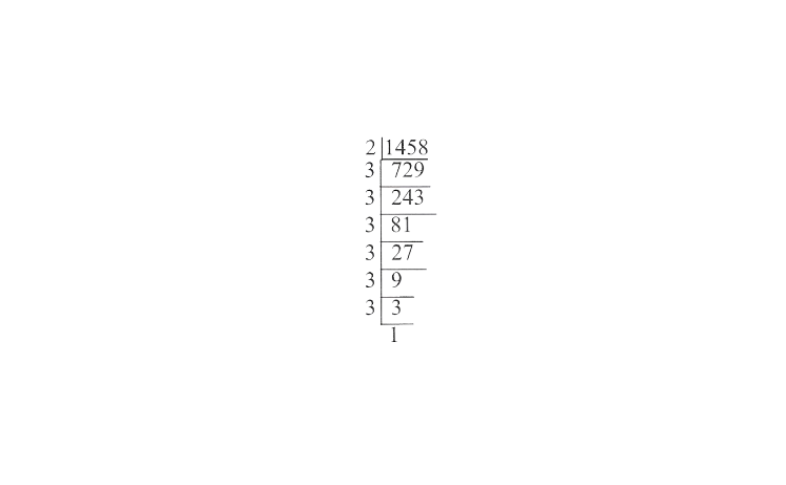
1458= 2x3x3x3x3x3x3
Here, prime factor 2 does not have its pair, If 2 gets a pair, then the number will become a perfect square.
∴ 1458 has to be multiplied with 2 to obtained a perfect square.
∴ 1458 x 2 = 2916 is a perfect square
1458 x 2 = 2916= 2x2x3x3x3x3x3x3
∴ √2916 = 2x3x3x3 = 54
6) 768
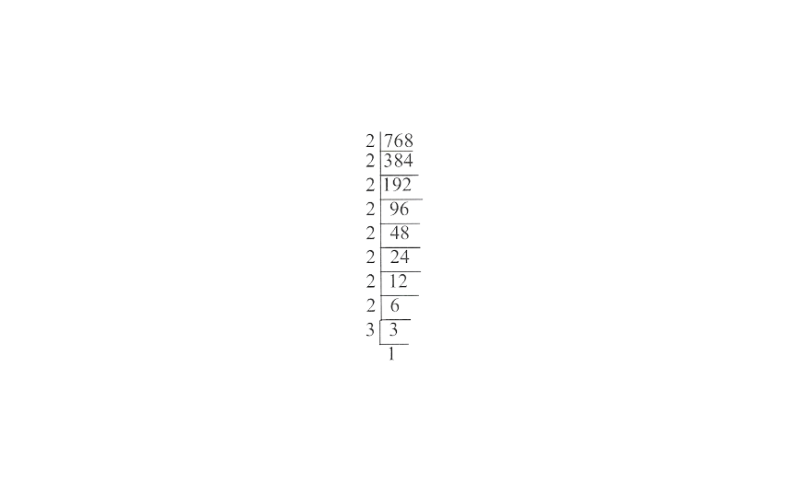
Karnataka Board Class 8 Maths Solutions For Squares And Square Roots
768= 2x2x2x2x2x2x2x2x3x2
Here, prime factor 3 does not have its pair, if 3 gets a pair, then the number will become a perfect square.
∴ 768×3 = 2304 is a perfect square
768 x 3 = 2304
= 2x2x2x2x2x2x2x2x3x3
∴ √2304 = 2x2x2x2x3 = 48
Squares And Square Roots Questions and Answers KSEEB Maths
6. For each of the following numbers, find the smallest whole number by which it should be divided so as to get a perfect square number. Also find the square root of the square number so obtained.
1) 252
2) 2925
3) 396
4) 2645
5) 2800
6) 1620
Solution:
1) 252
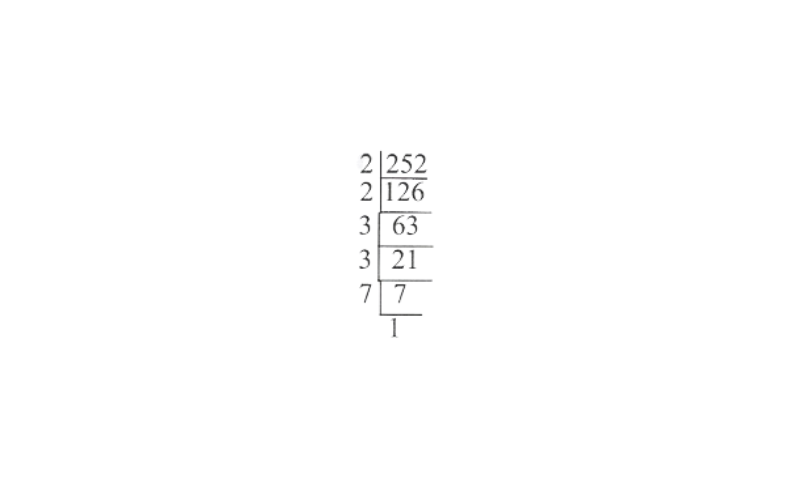
252 = 2x2x3x3x7
Here, prime factor 7 does not have its pair.
If we divide this number by 7, then the number will become a perfect square.
∴ 252 has to be divided by 7 to obtain a perfect square
252 ÷ 7 = 36 is a perfect square
36 = 2 x 2 x 3 x 3,
∴ √36 = 2×3 = 6
2) 2925
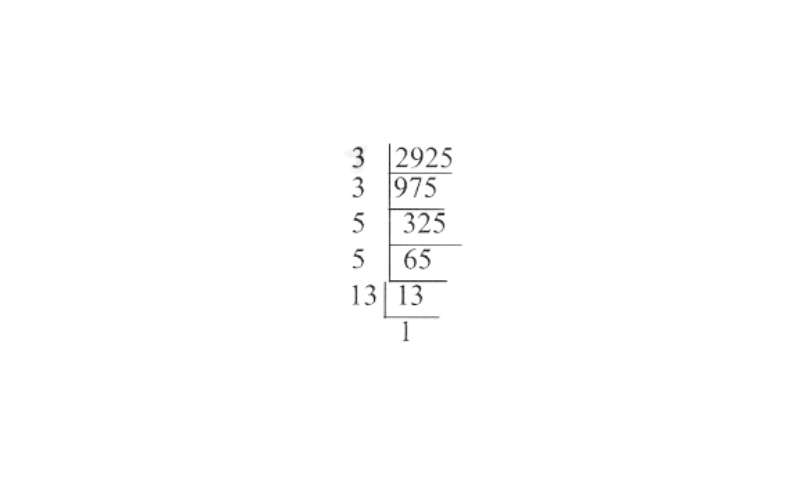
Here, prime factor 13 does not have its pair. If we divide this number by 13, then the number will become a perfect square.
∴ 2925 has to be divided by 13 to obtain a perfect square.
2925 ÷ 13 = 225 is a perfect square
225= 3x3x5x5
∴ √225= 3×5=15
3) 396
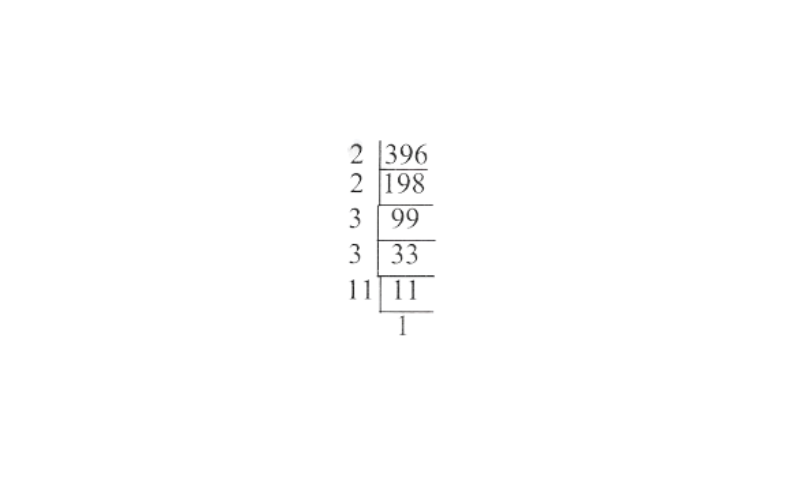
396 = 2 x 2 x 3 x 3 x 11
Here, prime factor 11 does not have its pair.
If we divide this number by 11, then the number will become a perfect square.
∴ 396 has to be divided by 11 to obtain a perfect square.
396 ÷ 11 = 36 is a perfect square
36 = 2x2x3x3
∴ √36 = 2×3 = 6
4) 2645
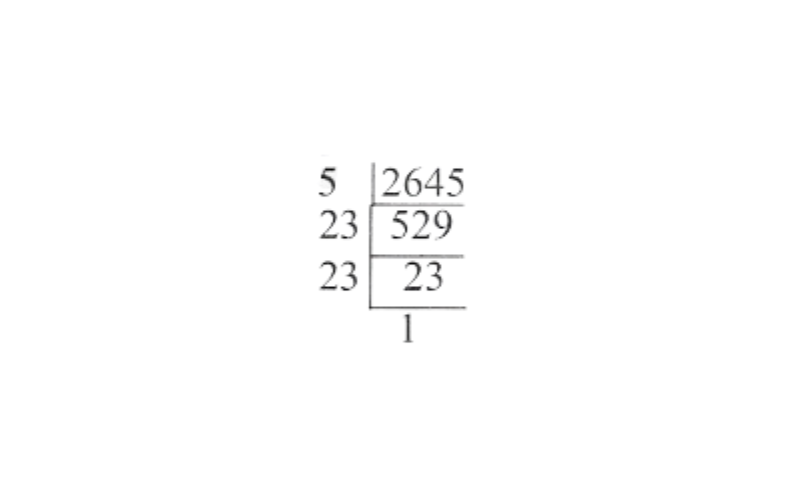
Kseeb Solutions For Class 8 Maths Pdf
If we divide this number by 5, then the number will become a perfect square.
∴ 2645 has to be divided by 5 to obtain a perfect square.
2645 ÷ 5 = 529 is a perfect square
529 = 23 x 23
∴ √529 = 23
5) 2800
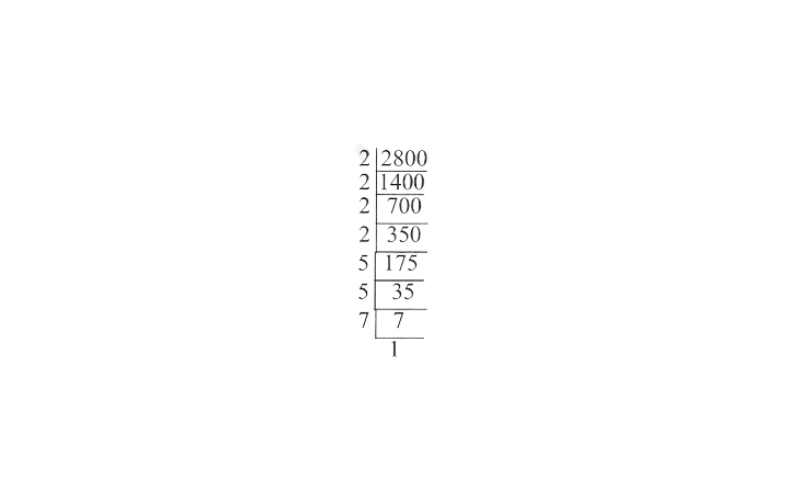
Here, prime factor 7 does not have its pair. If we divide this number by 7, then the number will become a perfect square.
∴ 2800 has to be divided by 7 to obtain a perfect square.
2800 ÷ 7 = 400 is a perfect square
400= 2x2x2x2x5x5
∴ √400 = 2x2x5 = 20
6) 1620
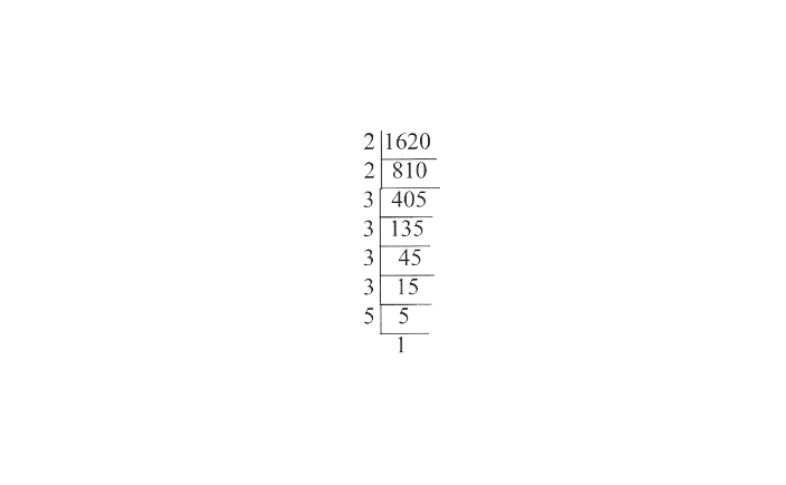
Here, prime factor 5 does not have its pair.
If we divide this number by 5, then theh number will become a perfect square.
∴ 1620 has to be divided by 5 to obtain a perfect square
1620÷5 = 324 is a perfect square.
324= 2x2x3x3x3x3
∴ √324 = 2x2x3 = 18
7. The student of class 8 of a school donated Rs. 2401 in all, for prime minister’s National Relief Fund. Each student donated as many rupees as the number of students in the class. Find the number of students in the class.
Solution: It is given that each student donated as many rupees as the number of students of the class. Number of students in the class will be the square root of the amount donated by the students of the class.
The total amount of donation is ₹2401.
Number of students in the class = √2401
2401 = 7x7x7x7
√2401 = 7×7 = 49
Hence, the number of students in the class is 49.
KSEEB Class 8 Maths Chapter 5 Squares and Square Roots
8. 2025 plants are to be planted in a garden in such a way that each row contains as many plants as the number of rows. Find the num-ber of rows and the number of plants in each row.
Solution: It is given that in the garden, each row contains as many plants as the number of rows.
Hence, number of rows = Number of plants in each row
Total number of plants = Number of rows x
Number of plants in each row.
Number of rows x Number of plants in each row = 2025
\((Number of rows)^2\) = 2025
Number of rows = √2025
2025 = 5x5x3x3x3x3
∴ √2025 = 5x3x3= 45
Thus, the number of rows and the number of plants in each row is 45.
9. Find the smallest square number that is divisible by each of the numbers 4,9 and 10.
Solution: The number that will be perfectly divisible by each one of 4, 9, 10 is their LCM.
The LCM of these numbers is as follows
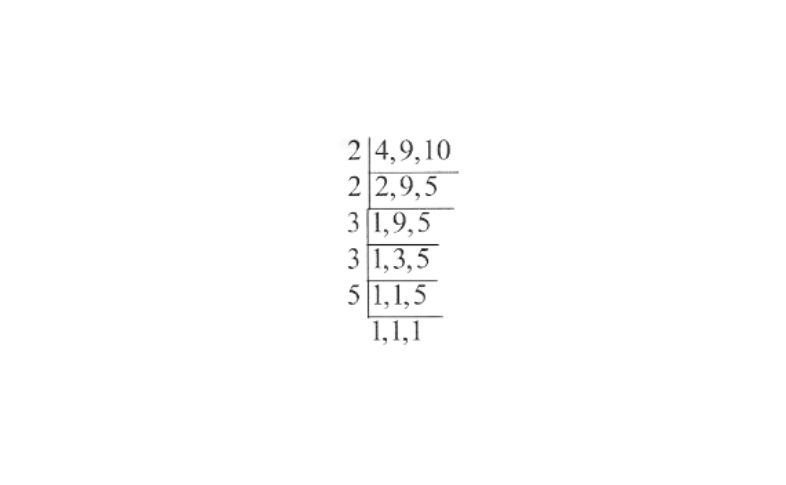
LCM of4, 9, 10= 2x2x3x3x5 = 180
Here, prime factor 5 does not have its pair,
∴ 180 is not a perfect square, If we multiply 180 with 5, then the number will become a perfect square.
∴ 180 should be multiplied with 5 to obtain a perfect square.
Hence, the required square number is
180 x 5 = 900
10. Find the smallest square number that is divisible by each of the numbers 8,15 and 20.
Solution: The number that is perfectly divisible by each of the numbers 8,15 and 20 is their LCM.
LCM of 8, 15 and 20 = 2 x 2 x 2 x 3 x 5 = 120
Here, prime factors 2,3 and 5 do not have their respective pairs,
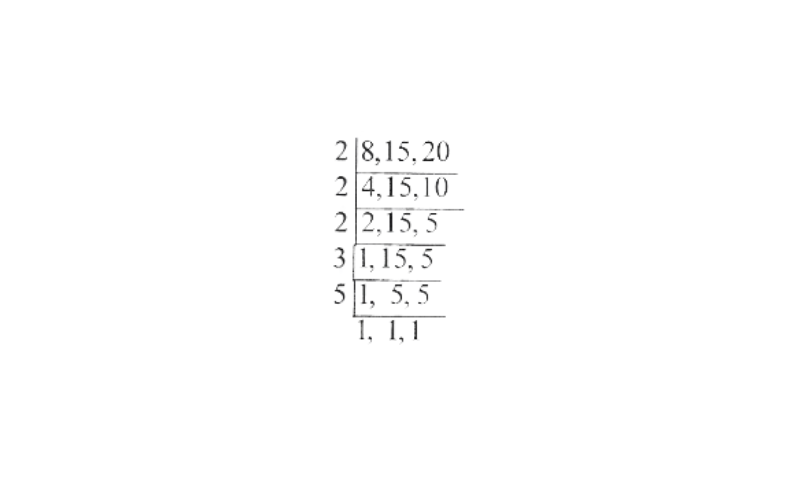
∴ 120 is not a perfect square.
∴ 120 should be multiplied by 2 x 3 x 5 ie 30, to obtain a perfect square.
Hence, the required square number is 120 x 2 x 3 x 5 = 3600
KSEEB Class 8 Maths Chapter 5 Solved Problems Square And Square Roots Excercise 5.4
1. Find the square root each of the following numbers by Division Method.
1)2304
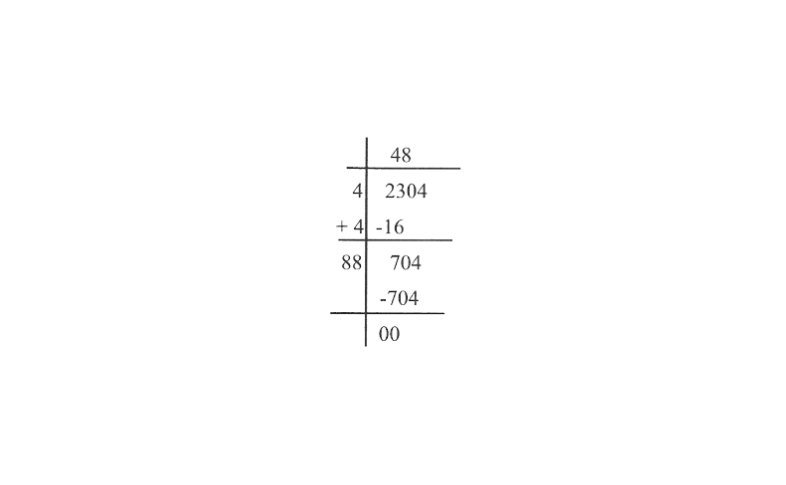
∴ √2304=48
2) 4489
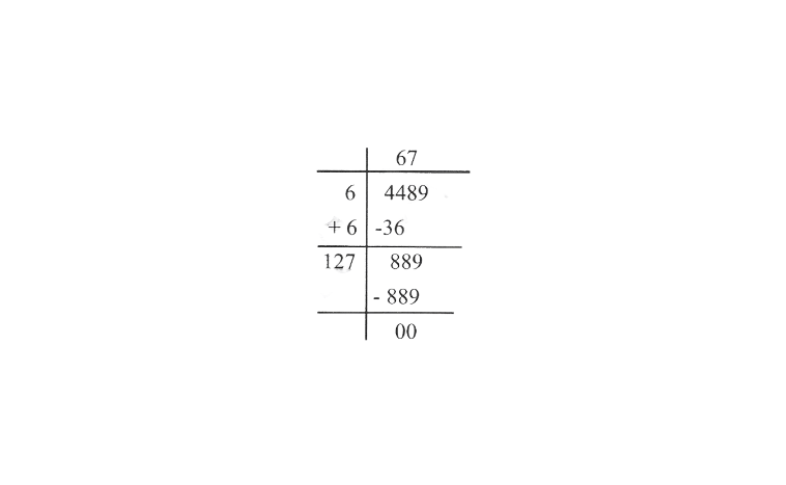
∴ √4489=67
3) 3481

∴ √3481=59
4) 529
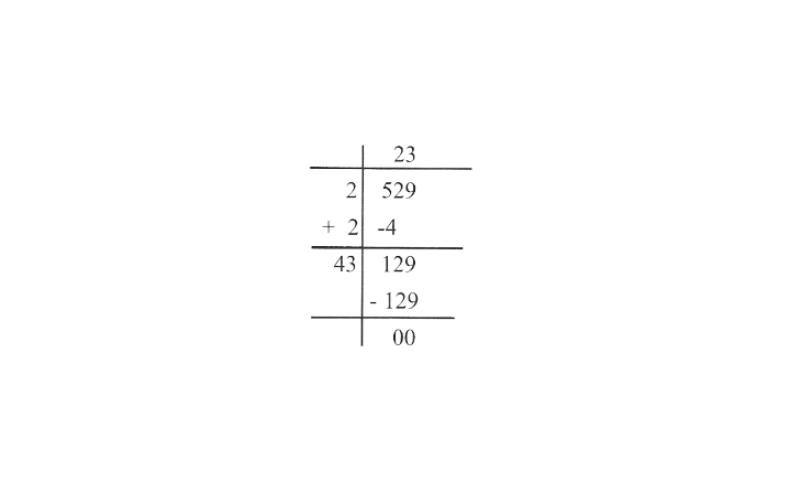
∴ √529=23
5) 3249
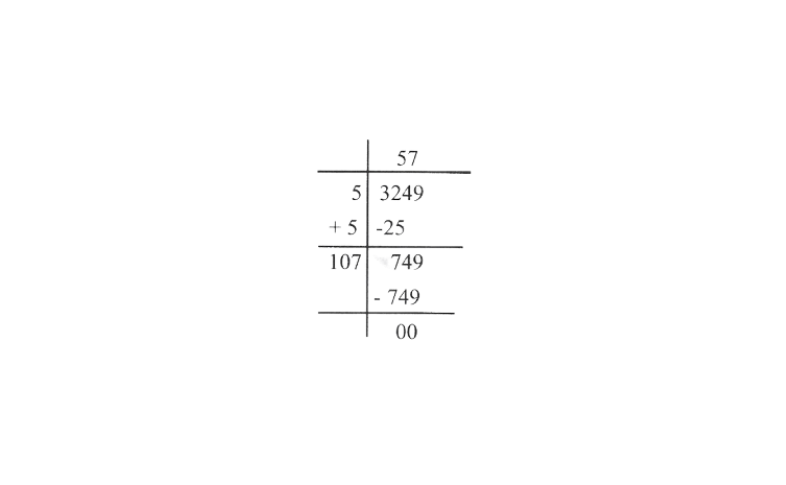
∴ √3249=57
6) 1369

∴ √1369=37
7) 5776
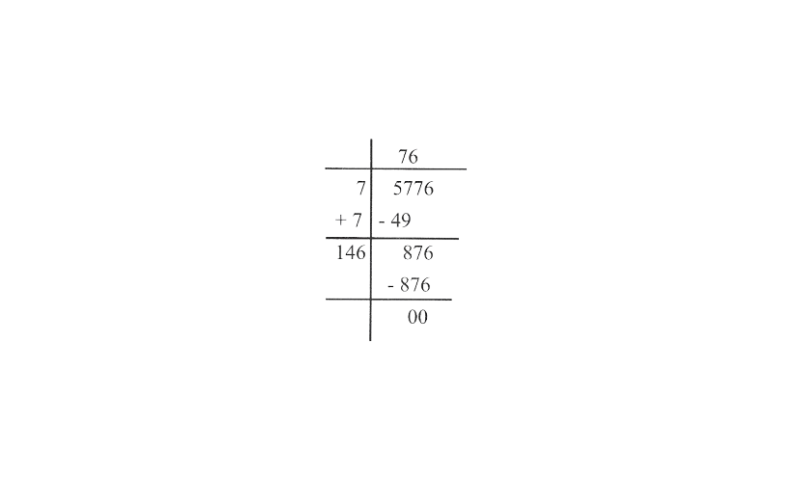
∴ √5776=76
8) 7921
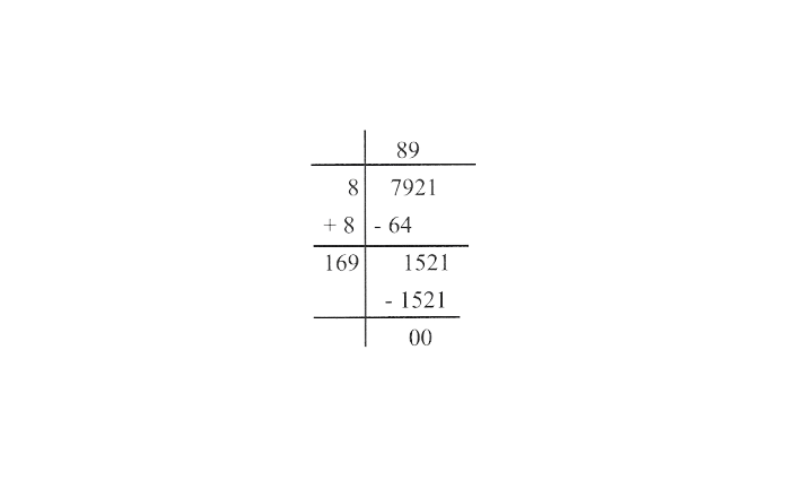
∴ √7921=89
9) 576
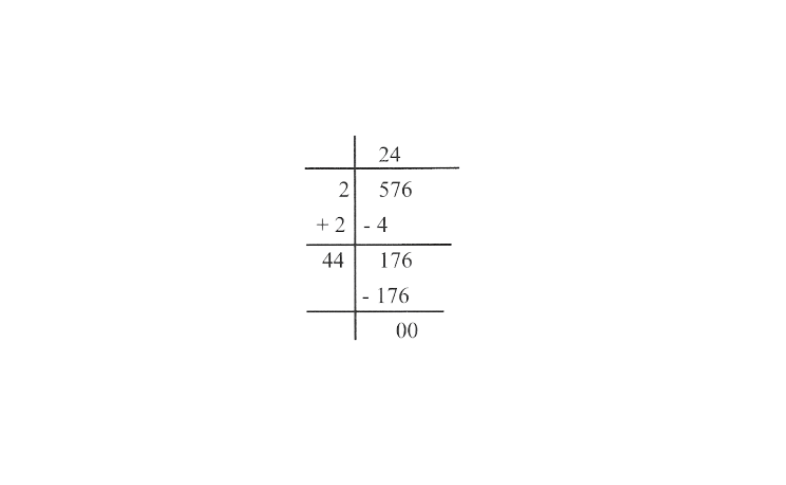
∴ √576=34
10) 1024
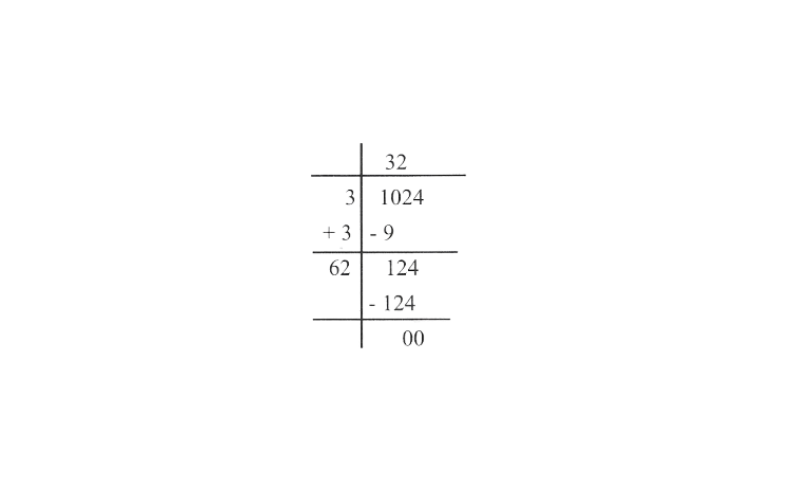
∴ √1024=32
11) 3136
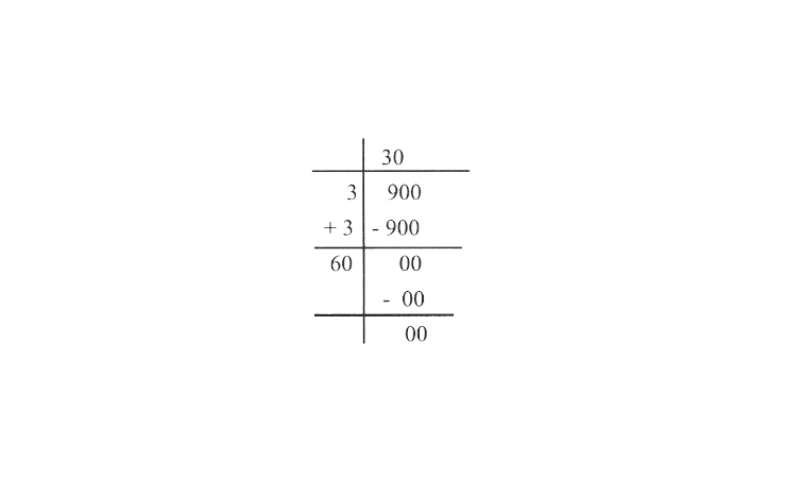
∴ √3136=56
12) 900
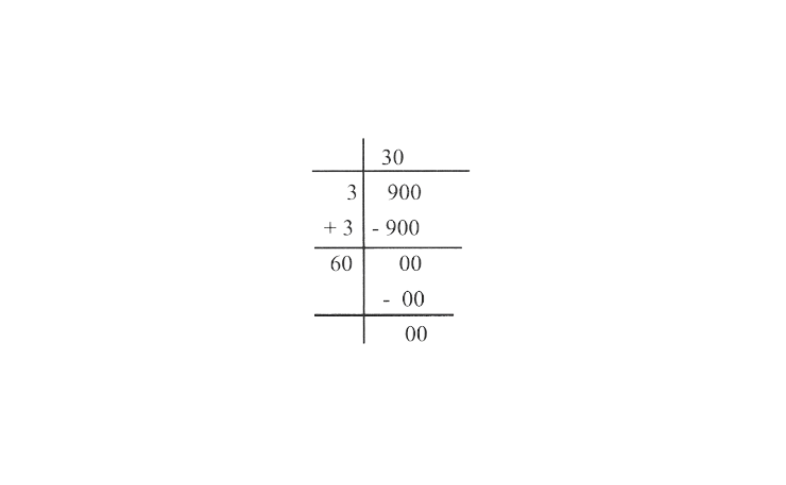
∴ √900=30
Kseeb Class 8 Squares And Square Roots Solutions Step By Step
2. Find the number of digits in the square root of the following numbers (without any calculation)
1) 64
2) 144
3) 4489
4) 27225
5) 390625
Solution:
1) By placing bars, we obtain
\(64=\overline{64}\)Since there is only one bar, the square root of 64 will have only one digit in it.
2) 144
= \(\overline{144}\)
Since there are two bars, the square root of 144 will have 2 digits in it.
3) 4489
= \(\overline{4489}\)
Since there are two bars, the square root of 4489 will have 2 digits in it.
4) 27225
= \(\overline{27225}\)
Since there are three bars, the square root of 27225 will have three digits in it.
5) 390625
= \(\overline{390625}\)
Since there are three bars, the square root of 390625 will have three digits in it.
3. Find the square root of the following decimal numbers.
1) 2.56
2) 7.29
3) 51.84
4) 42.25
5) 31.36
Solution:
1)2.56
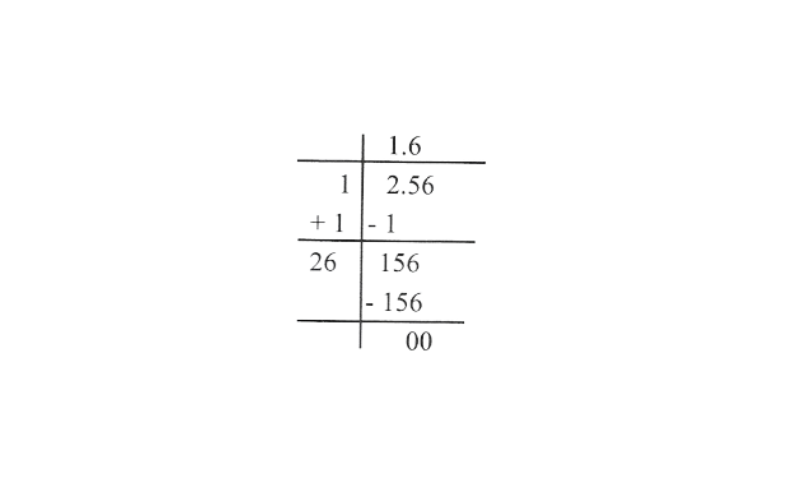
∴ √2.56=1.6
2)7.29
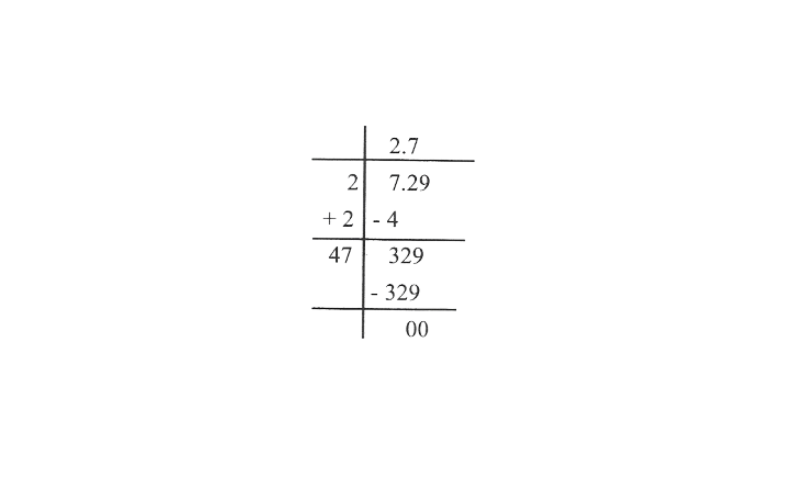
∴ √7.29=2.7
3) 51.84
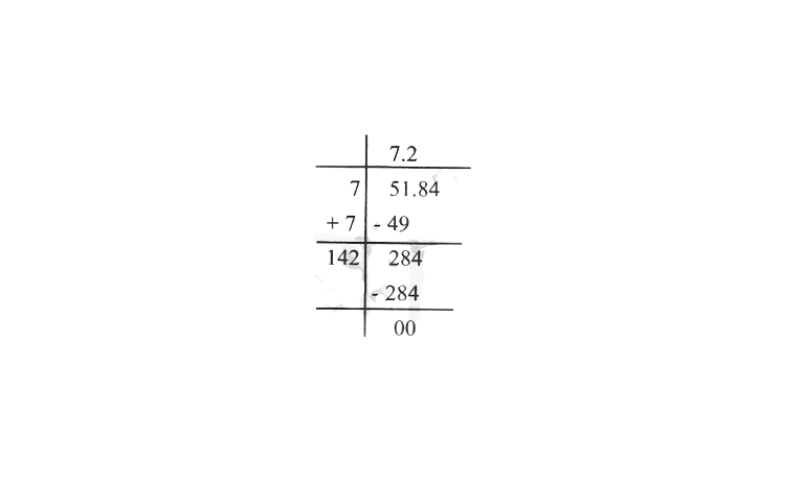
∴ √51.84=7.2
4)42.25
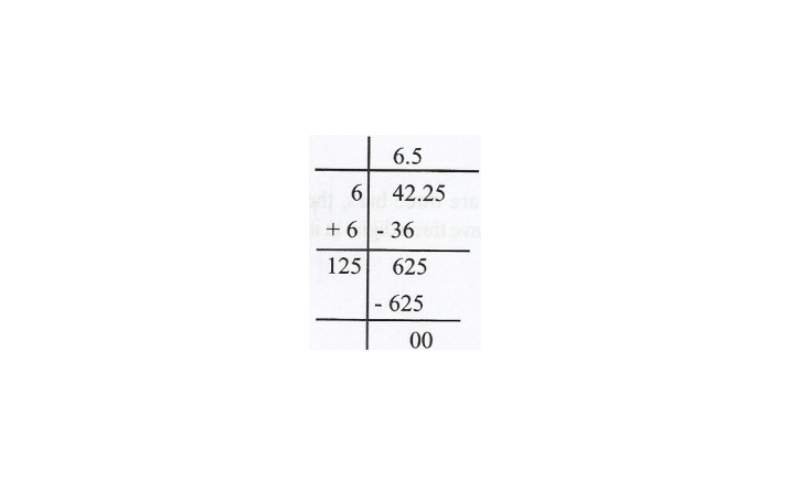
∴ √42.25=6.5
5)31.36
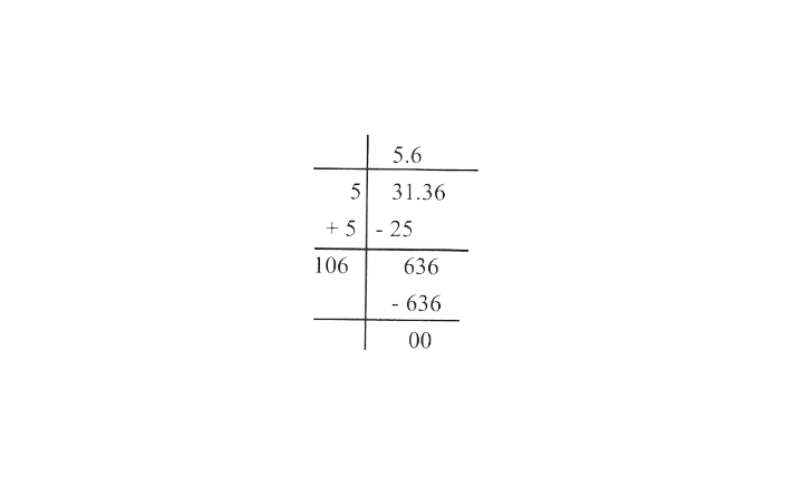
∴ √31.36=5.6
4. Find the least number which must be subtracted from each of the following numbers so as to get a perfect square so obtained.
1) 402
2) 1989
3) 3250
4) 825
5) 4000
Solution:
1) 402
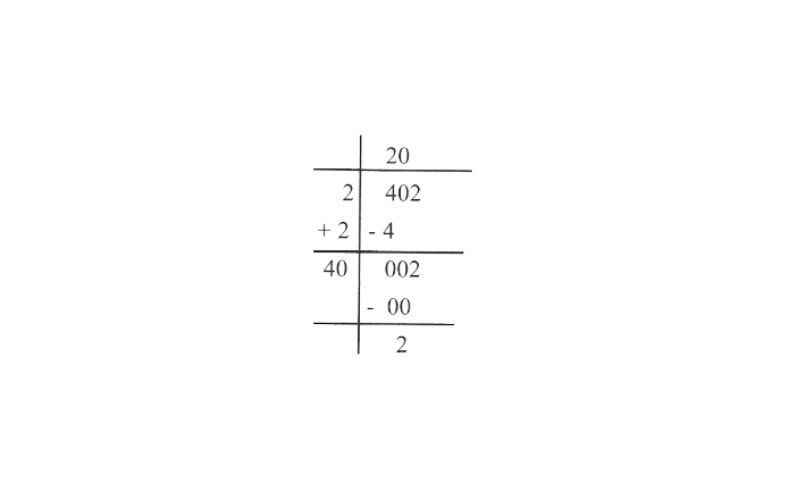
The remainder is 2, it represents that the square of 20 is less than 402 by 2
∴ a perfect square will be obtained by subtracting 2 from the given number 402.
∴ required perfect square = 402 – 2 = 400
∴ √400 = 20
ii) 1989
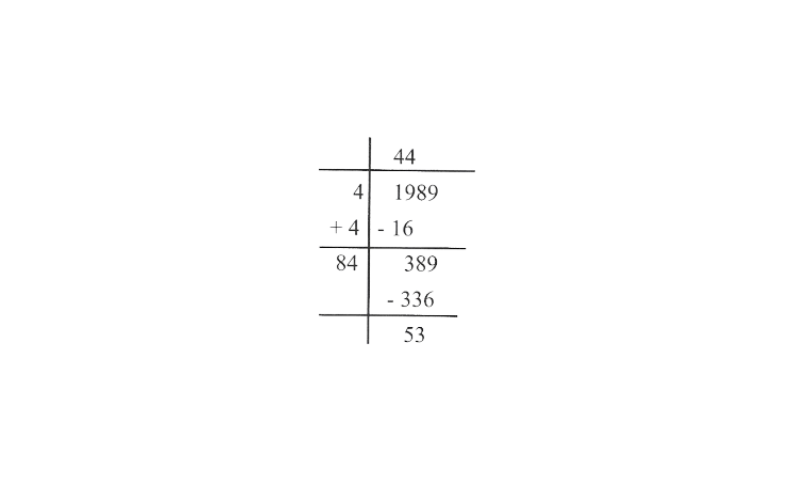
The remainder is 53, it represents that the square of 44 is less than 1989 by 53.
∴ a perfect square will be obtained by subtracting 53 from the given number 1989
∴ required perfect square = 1989 – 53
= 1936
∴ √l936 = 44
3) 3250
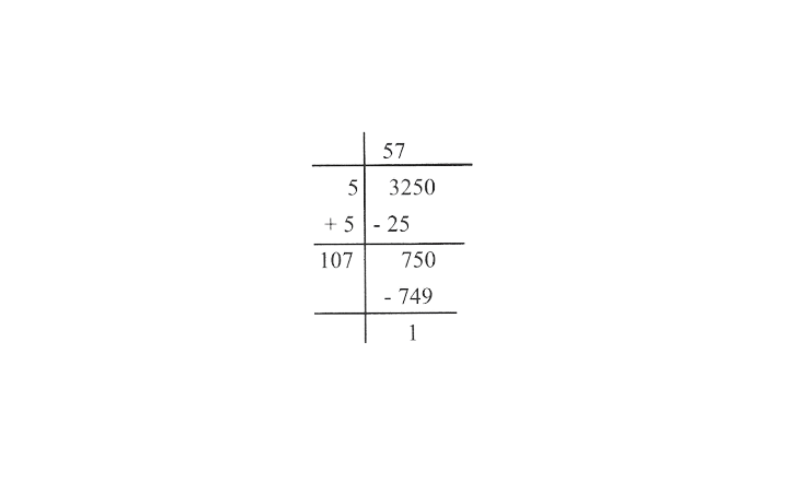
The remainder is 1, it represents that the square of 57 is less than 3250 by 1.
∴ a perfect square can be obtained by subtracting 1 from the given number 3250.
∴ required perfect square = 3250 – 1 = 3249
∴ √3249 =57
4) 825
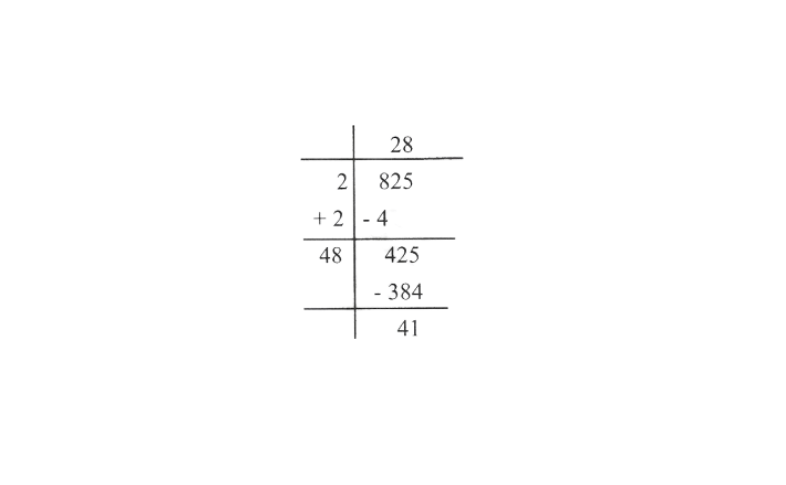
The remainder is 41, it represents that the square of 28 is less than 825 by 41.
∴ a perfect square can be calculated by subtracting 41 from the given number 825.
∴ required perfect square = 825 – 41 = 784 and √784 = 28
5) 4000
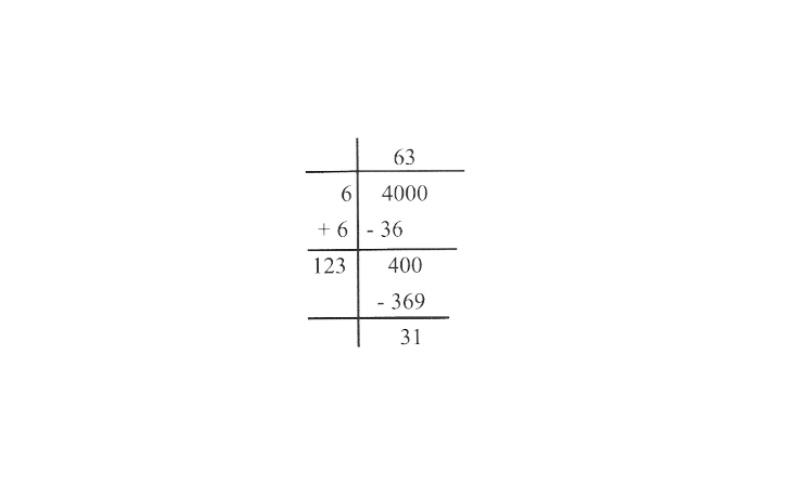
The remainder is 31, it represents that the square of 63 is less than 4000 by 31.
∴ a perfect square can be obtained by subtracting 31 from the given number 4000.
∴ required perfect square = 4000 -31 = 3969 and √3969 = 63
KSEEB Maths Class 8 Squares and Square Roots Notes
5. Find the least number which must be added to each of the following numbers so as to get a perfect square. Also, find the square root of the perfect square so obtained
1) 525
2) 1750
3) 252
4) 1825
5) 6412
Solution:
1) 525
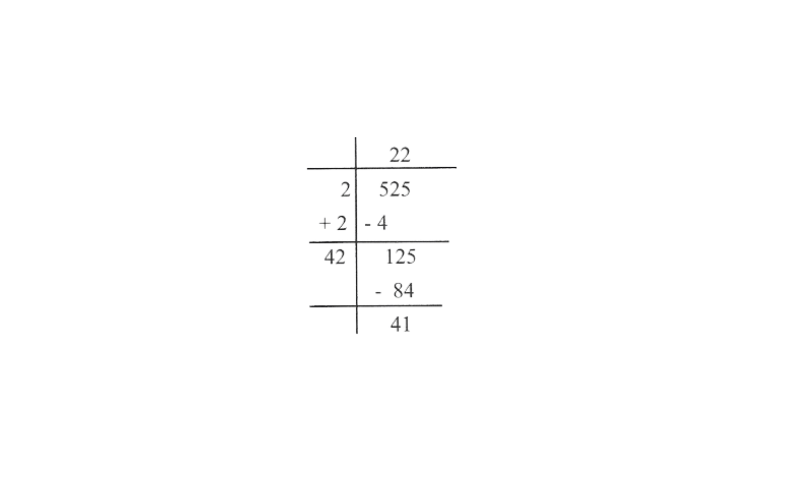
The remainder is 41.
It represents that the square of 22 is less than 525. Next number is 23 and \(23^2 = 529\)
Hence, number to be added to 525
= \(23^2 – 525 = 529 – 525 = 4\)
The required perfect square is 529 and
√529 = 23
2) 1750

The remainder is 69.
It represents that the square of41 is less than 1750, The next number is 42 and \(42^2 = 1764\)
Hence, number to be added to 1750
= \(42^2 – 17250\)
= 1764- 1750= 14
∴ The required perfect square is 1764 and √l764 = 42
3) 252
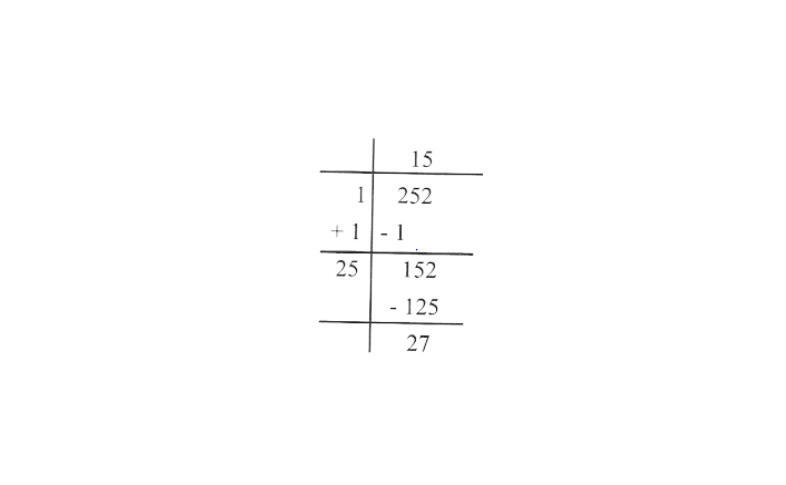
The remainder is 27. It represents that the square of 15 is less than 252.
The next number is 16 and \(16^2 = 256\)
Hence, number to be added \(252 = 16^2- 252
= 256 – 252 = 4\)
The required perfect square is 256 and
√256 = 16
4) 1825
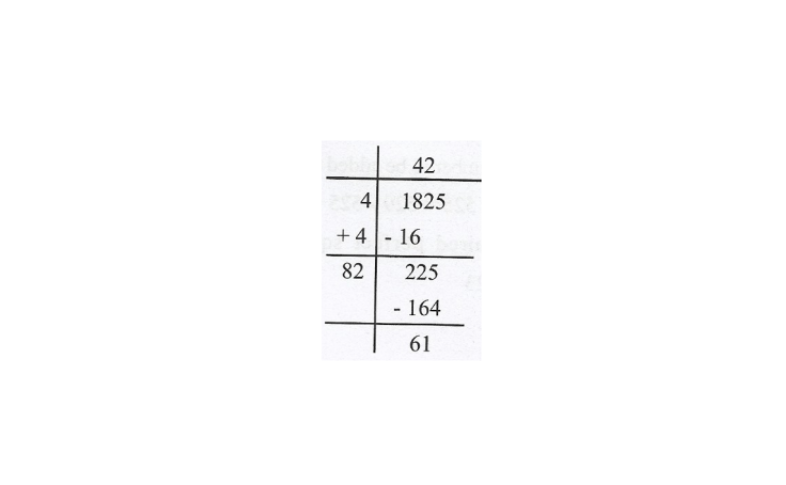
The remainder is 61.
It represents that the square of42 is less than 1825
The next number is 43 and \(43^2 = 1849\)
Hence, number to be added to \(1825 = 43^2 – 1825\)
= 1849 – 1825 = 24
The required perfect square is 1849 and
√l849 = 43
5) 6412
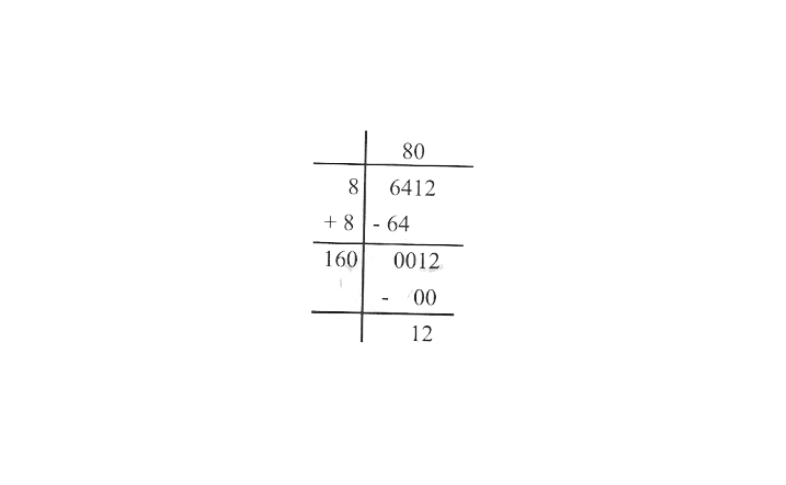
The remainder is 12.
It represents that the square of 80 is less than 6412. The next number is 81 and \(81^2 = 6561\)
Hence, number to be added to \(6412 = 81^2- 6412 = 6561 – 6412= 149\)
The required perfect square is 6561 and
√6561 = 81
KSEEB Class 8 Maths Key Concepts Of Squares And Square Roots
6. Find the length of the side of a square whose area is \(441m^2\).
Solution: Let the length of the side of the square be x m.
Area of square = \(x^2 = 44lm^2\)
x= √441
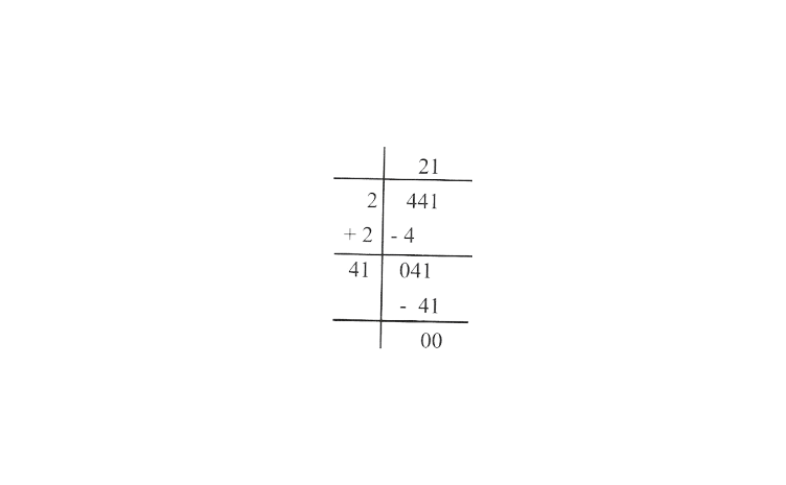
∴ x=21m.
Hence, the length of the side of the square is 21m
7. In a right triangle ABC, [B = 90° a) If AB = 6cm, BC = 8cm, find AC b) If AC = 13cm, BC = 5cm, find AB
Solution: a) △ABC is right angled at B.
∴ by applying Pythagoras theorem, we obtain
\(AC^2 = AB^2 + BC^2\) \(AC^2 = (6cm)^2 + (8cm)^2\) \(AC^2 = (36 + 64)^2 = 100cm^2\)AC = √100 = 10 cm
b) △ABC is right angled at B.
∴by applying Pythagoras theorem, we obtain
\(AC^2 = AB^2 + BC^2\) \((13)^2 = (AB)^2 + (5)^2\) \(AB^2 = 13^2 – 5^2 = 169 – 25 = 144 cm^2\)AB = √l44 cm= 12cm
AB = 12cm
8. A gardener has 1000 plants. He wants to plant these in such away that the number of rows and the number of columns remain same. Find the minimum number of plants he needs more for this.
Solution: It is given that the gardener has 1000 plants. The number of rows and the number of columns is the same. We have to find the number of more plants that should be there, so that when the gardner plants them, the number of rows and columns are same. That is, the number which should be added to 1000 to make it a perfect square has to be calculated.
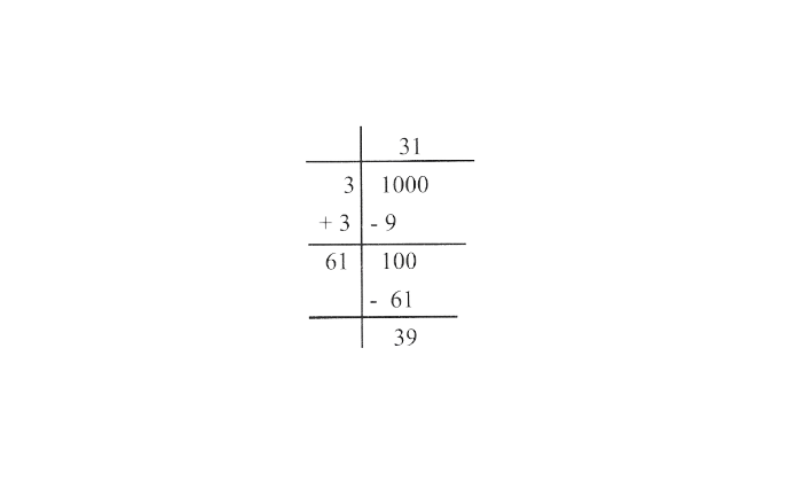
The remainder is 39, it represents that the square of 31 is less than 1000.
The next number is 32 and 322 = 1024
Hence, number to be added to 1000 to make it a perfect square = \(32^2-1000=1024-1000=24\)
Thus, the required number of plants is 24.
9. These are 500 children in a school. For a P.T. drill they have to stand in such a manner that the number of rows is equal to number of columns. How many children would be left out in this arrangement?
Solution: It is given that there are 500 children in the school. They have to stand for a P.T. drill such that the number of rows is equal to the number of columns. The number of children who will be left out in this arrangement has to be calculated. That is, the number which should be subtracted from 500 to make it a perfect square has to be calculated.
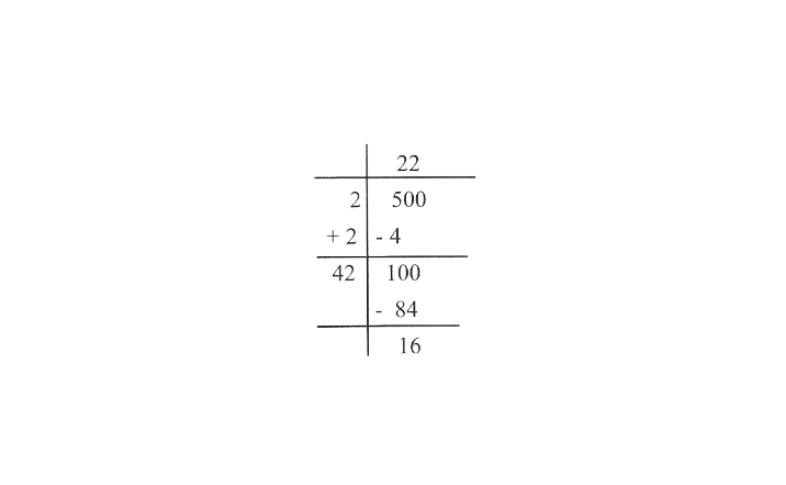
The remainder is 16. It shows that the square of 22 is less than 500 by 16.
∴ If we subtract 16 from 500, we will obtain a perfect square.
Required perfect square = 500 – 16 = 484 Thus, the number of children who will be left out is 16.
Chapter 5 Squares And Square Roots Solutions KSEEB Maths Additional Problems
1. Which of the following are perfect squares
a) 16
b) 54
Solution:
a) 16
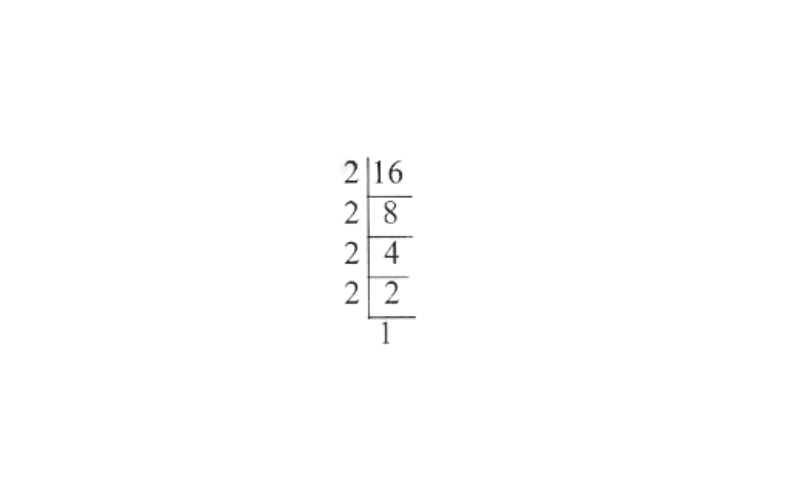
Prime factors of 16 are = 2x2x2x2
Prime factors occur in pairs of like factors, so 16 is a perfect square.
b) 54
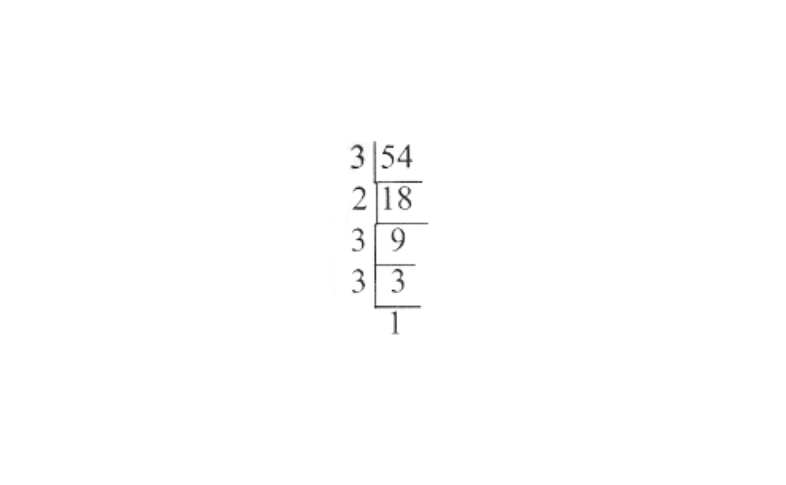
Prime factors of 54 are
= 2x3x3x3
= 2 x (3 x 3) x 3
We observe here that there are three 3’s, two form a pair but one is left. 2 also does not have a like factor to form a pair with, thus 54 is not a perfect square.
2. Find the greatest number of 3 – digit which is a perfect square.
Solution: w.k.t. the greatest number of three digit is 999. But 999 is not a perfect square so we must find the smallest number which must be subtracted from 999 to make it a perfect square.
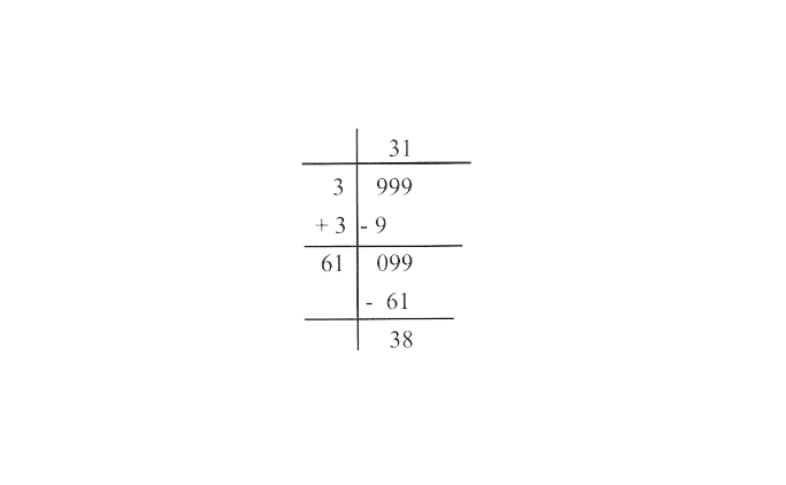
This shows that if we subtract 38 from 999, the resulting number will be a perfect square.
Thus 999 – 3 = 961 is the greatest number of 3 digits which is a perfect square.
3. Find the square root of the following decimals.
a) 1043.29
b) 0.000676
Solution:
a) 1043.29
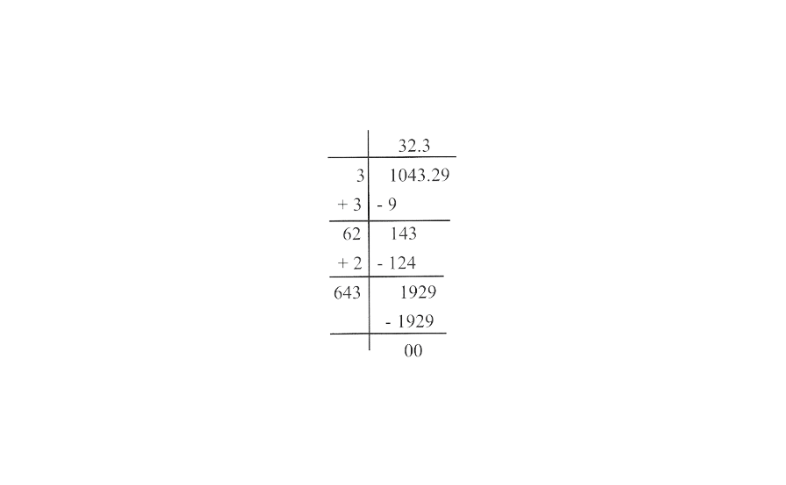
∴ √1043.29 = 32.3
b) 0.000676
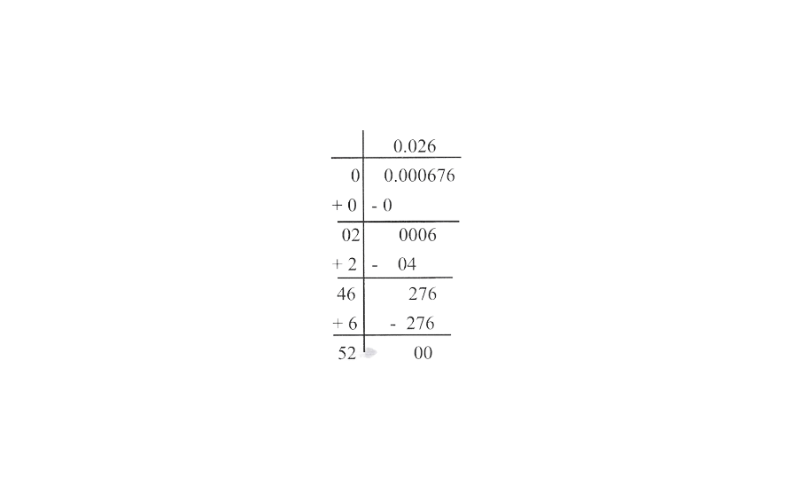
∴ √0.000676=0.026
4. Write a Pythagorean triplet whose one number is 6.
Solution: For any natural number m > 1, 2m, \(m^2 – 1 and m^2+ 1\) forms a pythagorean triplet.
If we take \(m^2 – 1 = 6\)
then, \(m^2 = 6 + 1 = 7\)
the value of m will not be an integer.
If we take \(m^2 + 1 = 6\)
then \(m^2 = 6 – 1 = 5\)
Again the value of m will not be an integer So, let 2m = 6
m= 3
thus, \(m^2 – 1 = 3^2 – 1 = 8\)
\(m^2 + 1 = 3^2 + 1 = 10\)So, the required triplet is 6,8,10
KSEEB Class 8 Maths Chapter 5 Squares And Square Roots
5. Rahul walks 12 m North from his house and turns west to walk 35m to reach his friend’s house. While returning, he walks diagonally from his friend’s house to reach back to his house. What distance did he walk while returning?
Solution: Applying Pythagoras in △ABC we have

AC= √1369 = 37m
6. Find three numbers in the ratio 2:3:5, the sum of whose squares is 608.
Solution: Let three numbers be 2x, 3x and 5x According to question,
\( (2x)^2 + (3x)^2 + (5x)^2 = 608\) \( 4x^2 + 9x^2 + 25x^2 = 608\) \( 38x^2 = 608\) \( x^2 = 608 /38\) \( x^2= 16\)X= √16
x = √2x2x2x2 = 4 Numbers are 8, 12 and 20
7. The area of a square plot is 101 1/400 \( m^2\) . Find the length of one side of the plot.
Solution: Let the length of one side be x m Then area of square = \( x^2\)
∴ \(x^2 = 101 1/400\)
\(x^2=40401/400\)x= √40401/400
x= 201/20
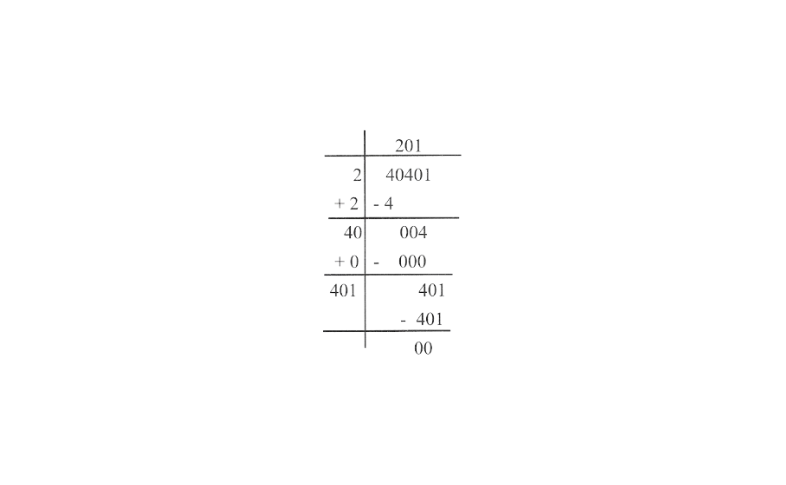
x=101/20
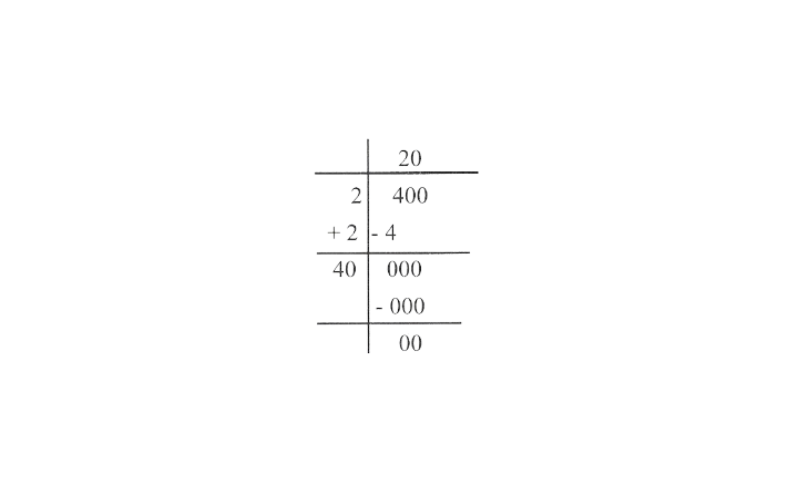
So, length of each side = 10 1/20m
8. The area of a rectangular field whose length is twice its breadth is \(2450m^2\). Find the perimeter of the field.
Solution: Let the breadth of the field be x metres, then length of the field is 2x metres.
∴ area of the rectangular field = length x breadth
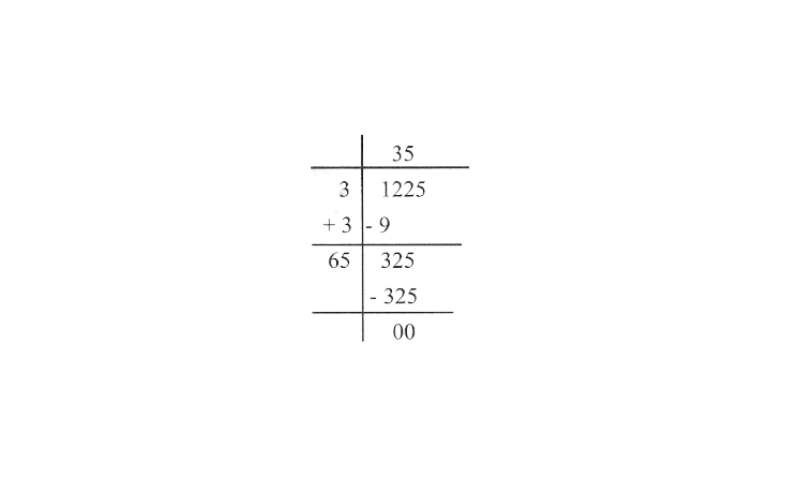
= \(2x x X = (2x^2)m^2\)
Given that area is \( 2450m^2\)
\( 2x^2 = 2450\) \( x^2=2450/2\)⇒ X = √l225 or x = 35 m
Hence breadth = 35m and length = 35 x 2 = 70m
Perimeter of the field =2 (l + b)
= 2(70 + 35)m
= 2 x 105m = 210m
9. 13 and 31 is a strange pair of numbers such that their squares 169 and 961 are also mirror images of each other. Find two other such pairs?
Solution: As per the question, 13 and 31 are palindrome and llly its square will also be a palindrome. Now if I take 12 and 21 then there square will be 144 and 441
Hence, 12 and 21 are such pair.
10. During a mass drill exercise 6,250 students of different schools are arranged in rows such that the number of students in each row is equal to the number of rows. In doing so, the instructor finds out that 9 children are left out. Find the number of children in each row of the square.
Solution: Total number of students = 6250 Number of students forming a square = 6250-9 = 6241
Thus, 6241 students form a big square which has number of rows equal to the number of students in each row. Let the number of students in each row be x, then the number of rows
= x
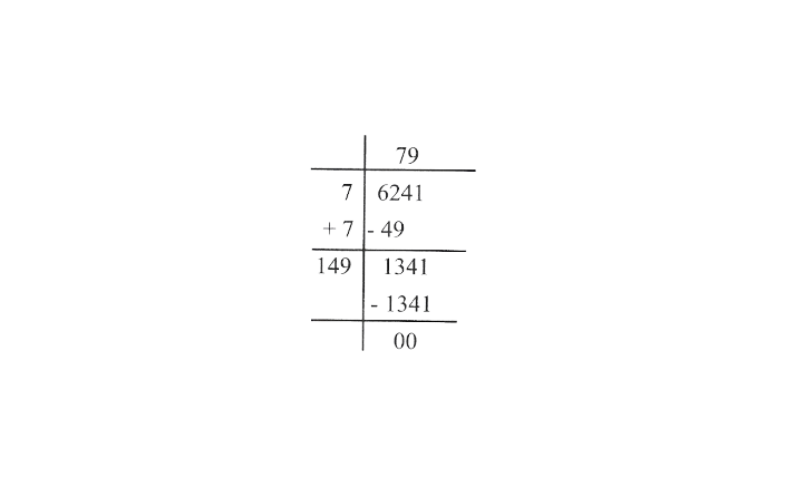
∴ X x X = 6241
\( x^2 = 6241\)⇒ x= √6241
x=79
Hence, there are 79 students in each row of the square formed.
KSEEB Maths Class 8 Squares and Square Roots
11. Find the perfect square numbers between 40 and 50.
Solution: Perfect square numbers between 40 and 50 = 49
12. Which of the following \( 24^2,49^2, 77^2, 131^2 or 189^2\) end with digit 1?
Solution: Only \( 49^2, 131^2and 189^2\) end with digit 1.
13. Check whether (6, 8, 10) is a Pythagorean triplet.
Solution: 2m, \( m^2 -1 and m^2 + 1\) represent the Pythagorean triplet.
Let 2m = 6 ⇒ m = 3
\(m^2 – 1 = 3^2 – 1 = 9 – 1 = 8\) and
\(m^2 + 1 = 3^2+ 1 = 9+ 1 = 10\)Hence (6,8,10) is a pythagorean triplet.
14. Find the square root of the following using successive subtraction of odd numbers starting from 1
a) 81
b) 25
Solution:
a) 81
81 – 1 = 80,
80 – 3 = 77,
77 – 5 = 72,
12 – 1 = 65,
65 – 9 = 56,
56 – 11 = 45,
45 – 13 = 32,
32- 15= 17,
17-17 = 0
We have subtracted 9 times to get 0.
∴ √81 = 9
b) 25
25-1 =24,
24-3 = 21,
21 – 5 = 16,
16-7 = 9,
9-9 = 0
We have subtracted 5 times to get 0
∴ √25 = 5
15. Find the cost erecting a fence around a square field whose area is 9 hectares if fencing costs ₹35 per metre.
Solution: Area of the square field =\( (9 x 10000)m^2\)
= \(90000m^2\)
length of each side of the field = √90000 m
= 300m
Perimeter of the field = (4 x 300)m = 1200m Cost of fencing = ? (1200 x35) = ₹42000
16. In an auditorium, the number of rows is equal to the number of chairs in each row, If the capacity of the auditorium is 2025, find the number of chairs in each row.
Solution: Let the number of chairs in each row be x
Then, the number of rows =x
Total number of chairs in the auditorium
= \((x x x) = x^2\)
but, the capacity ofthe auditorium = 2025 (given)
∴ x^2 =2025 = 5x5x3x3x3x3

x = 5x3x3 = 45
Hence, the number of chairs in each row = 45.
17. A ladder 10m long rests against a vertical wall. If the foot of the 1 adder is 6m away from the wall and the ladder just reaches the top of the wall, how high is the wall?
Solution: Let AC be the ladder
∴ AC = 10m,

Let BC be the distance between the foot of the ladder and the wall,
∴ BC = 6cm
△ABC forms a right-angled triangle, right-angled at B
By Pythagoras theorem,
\(AC^2 + AB^2 + BC^2\) \(10^2 = AB^2 + 6^2\) \(AB^2 = 10^2 – 6^2\)= 100 – 36 = 64
⇒AB = √64 = 8m
Hence, the wall is 8m high.
